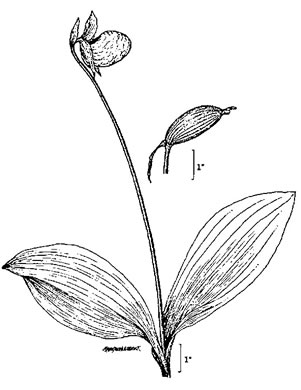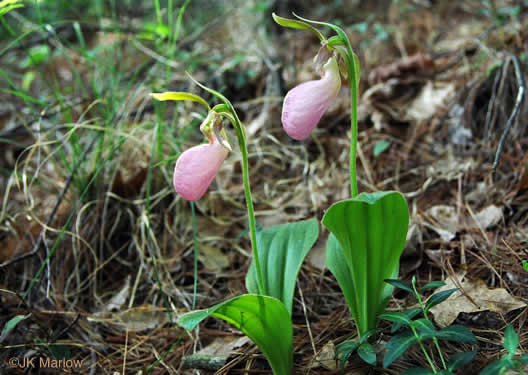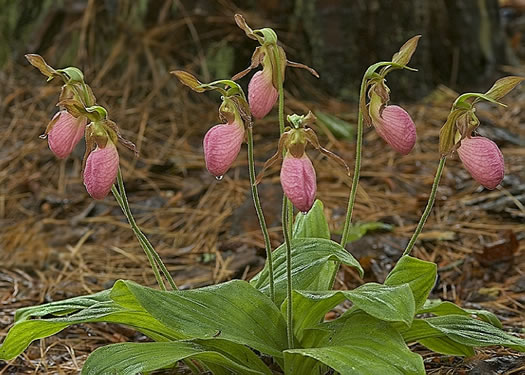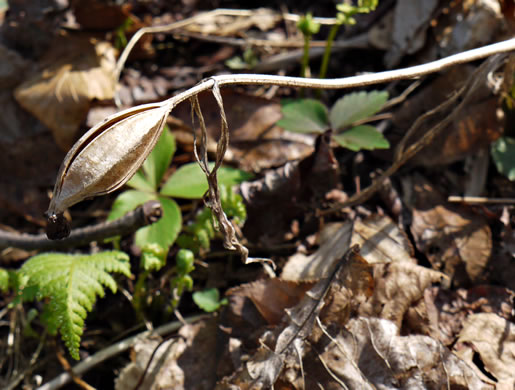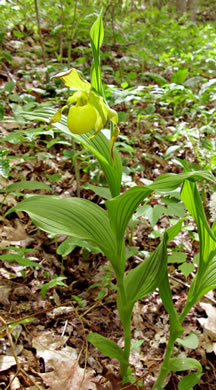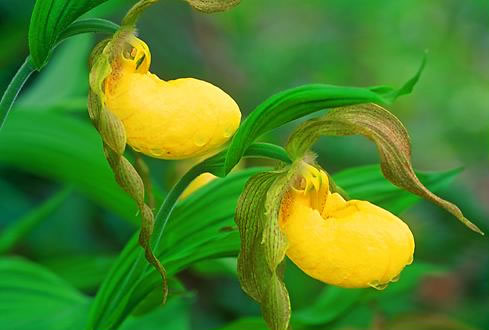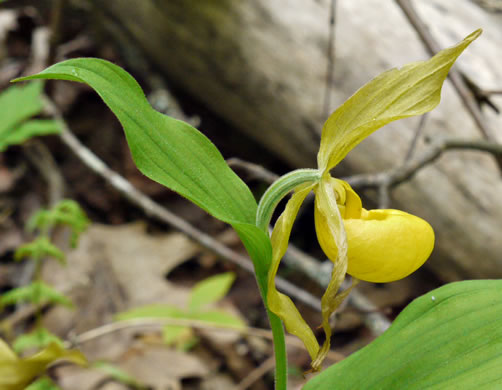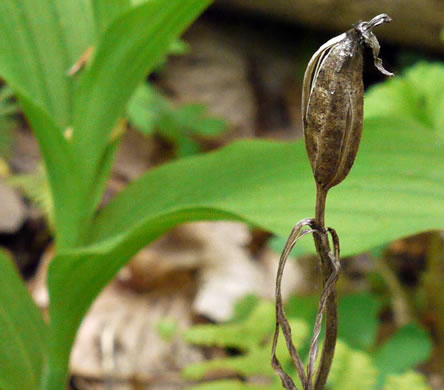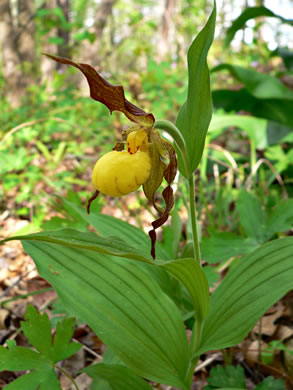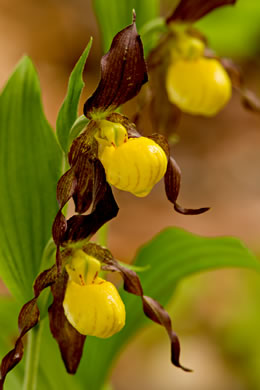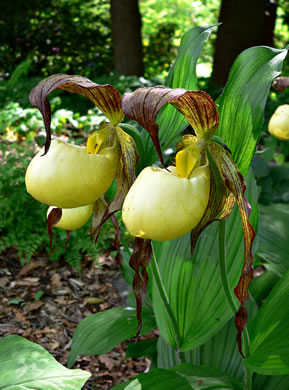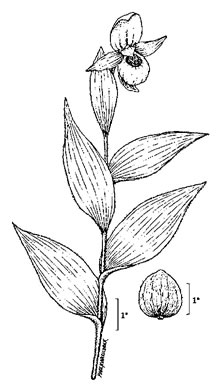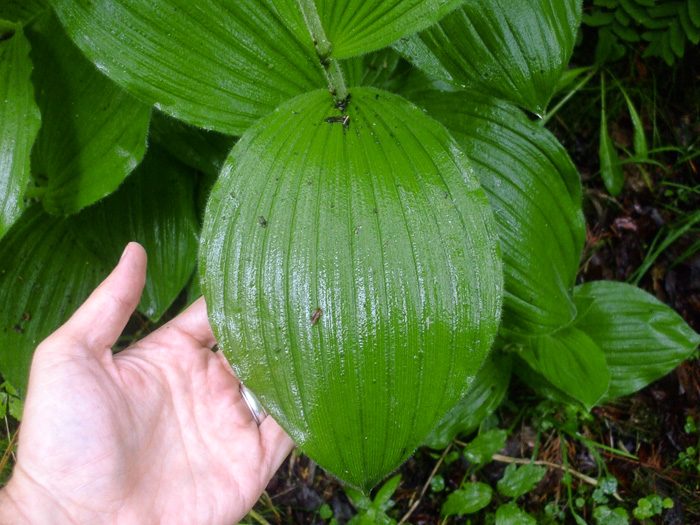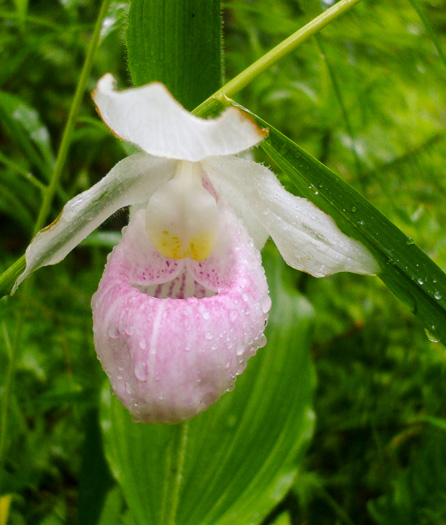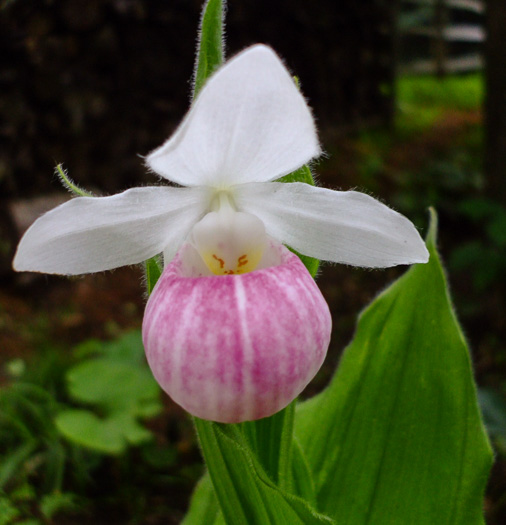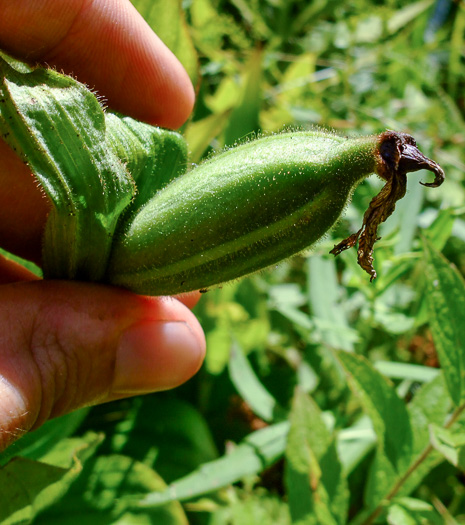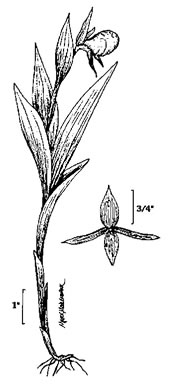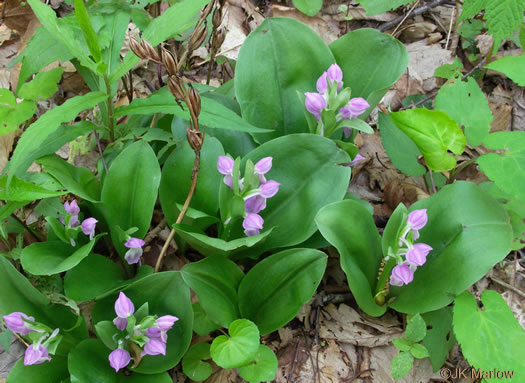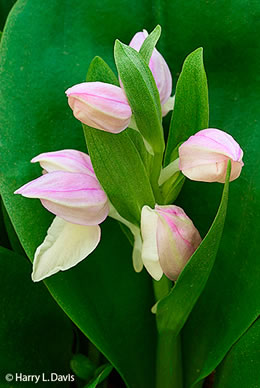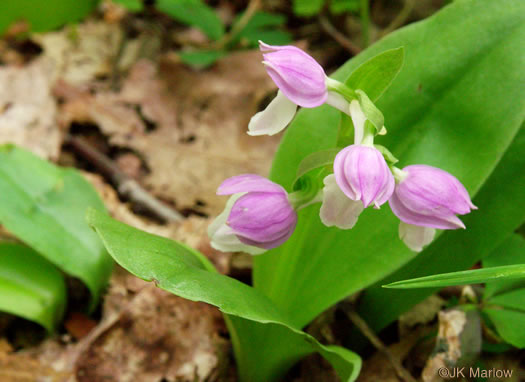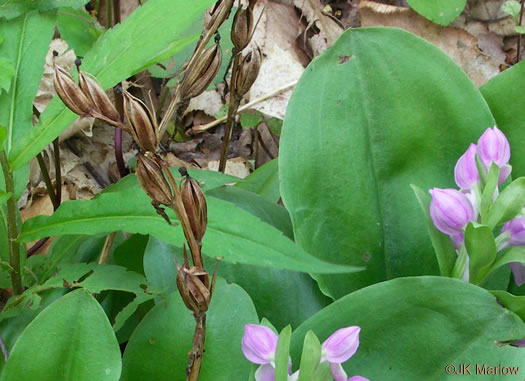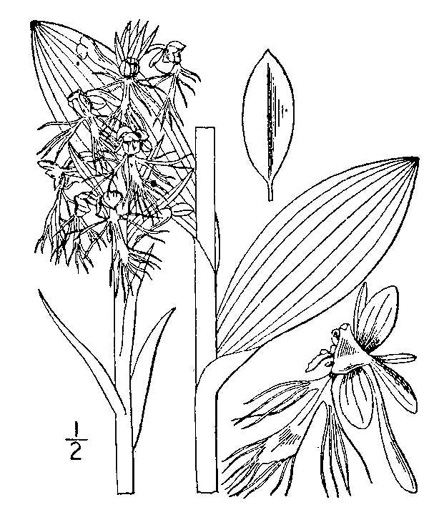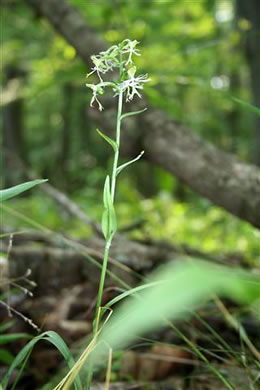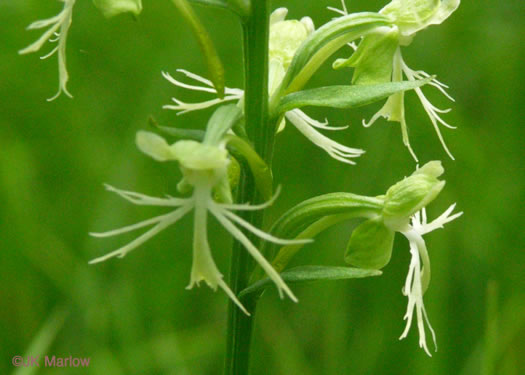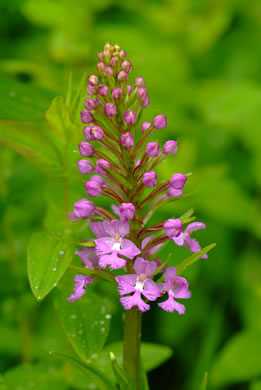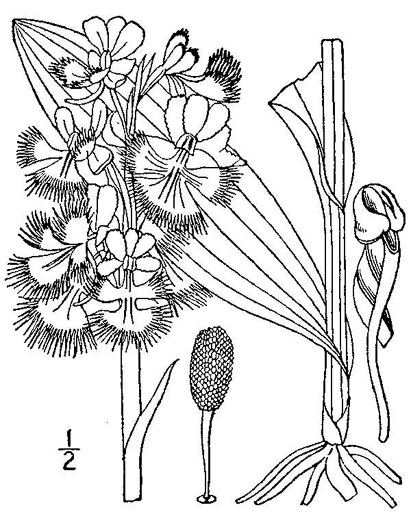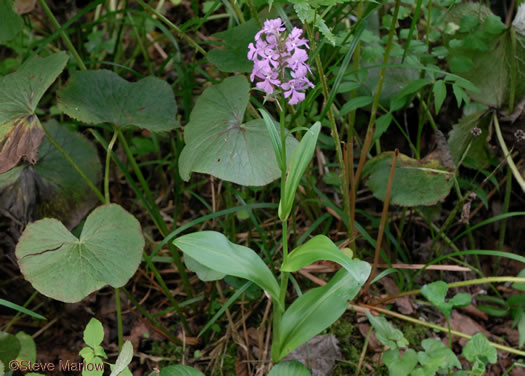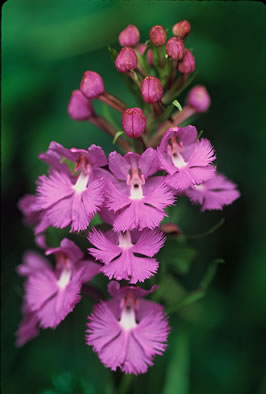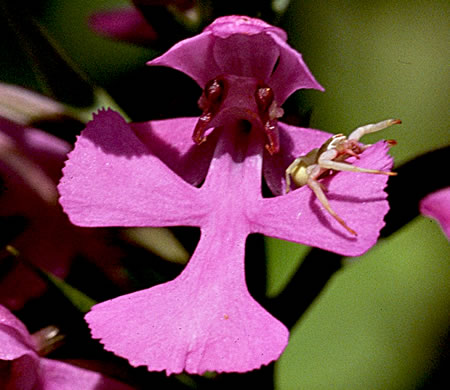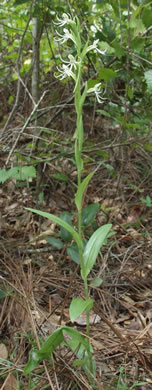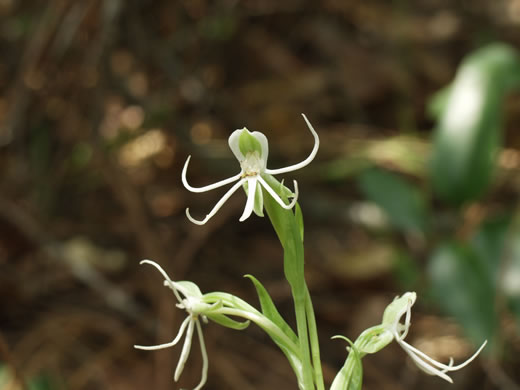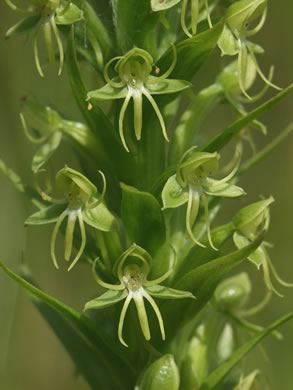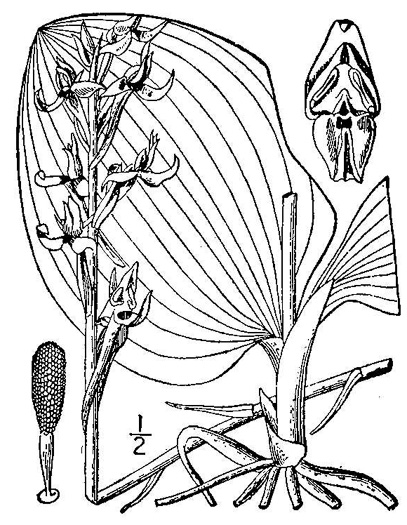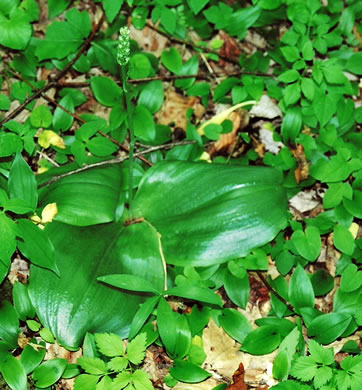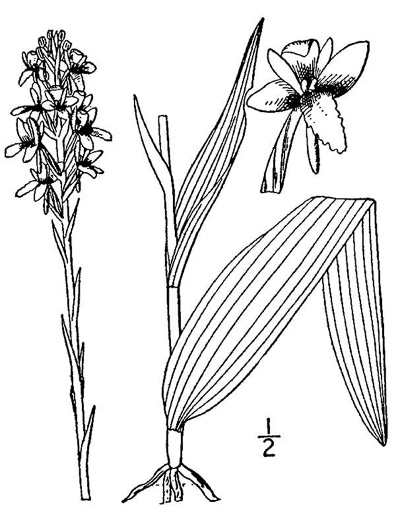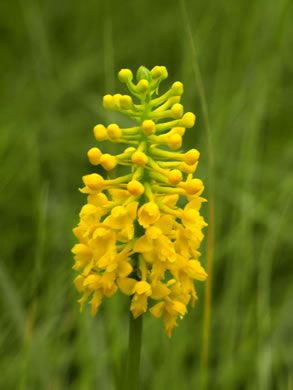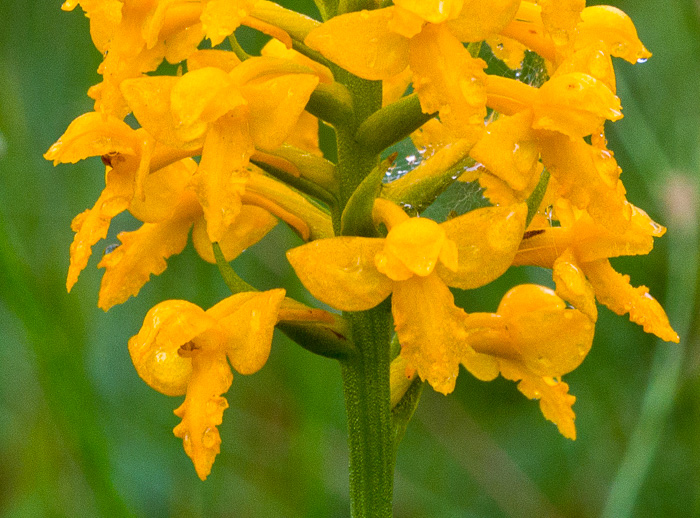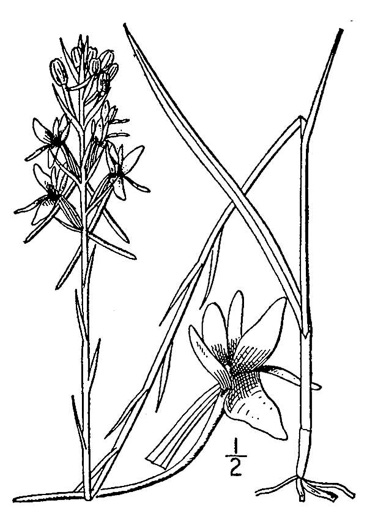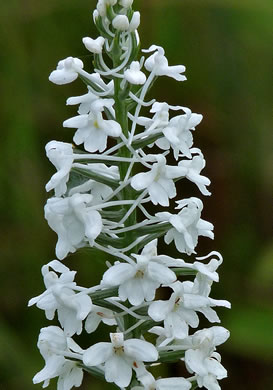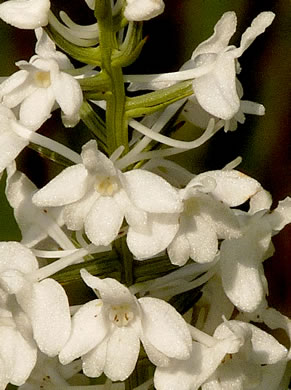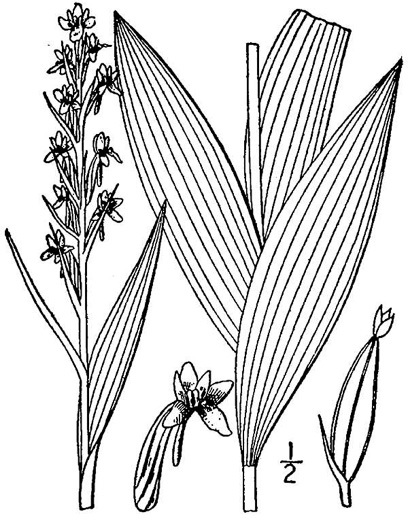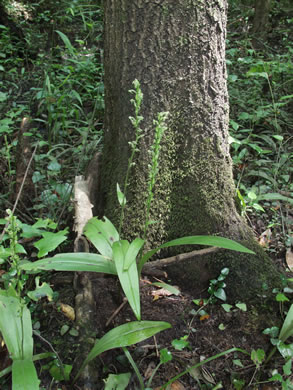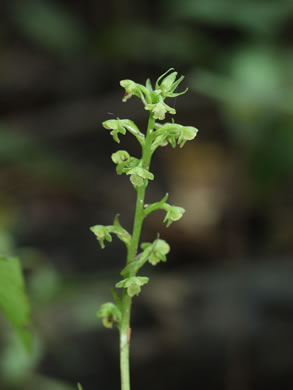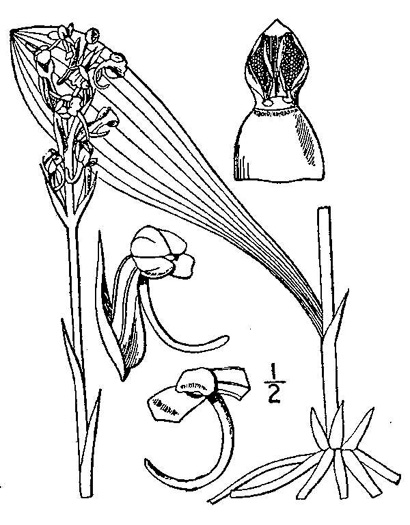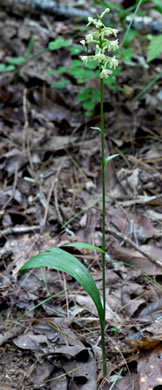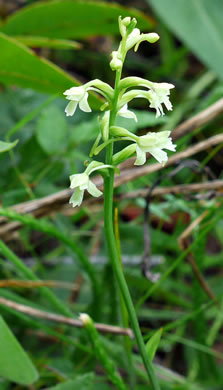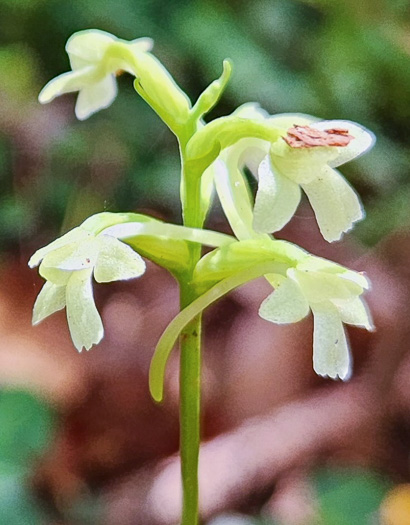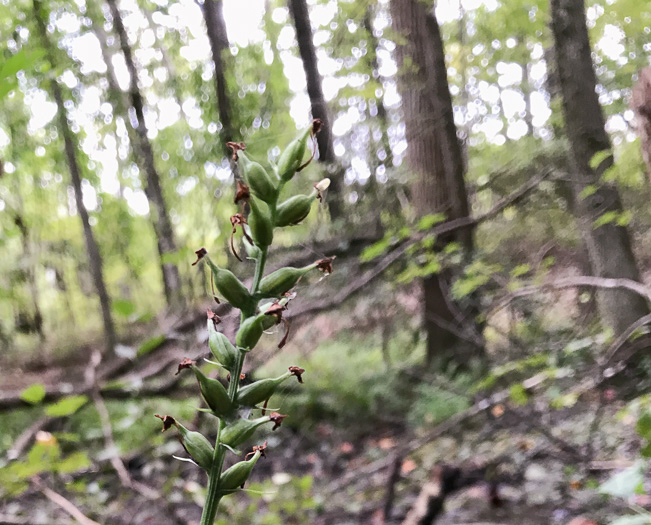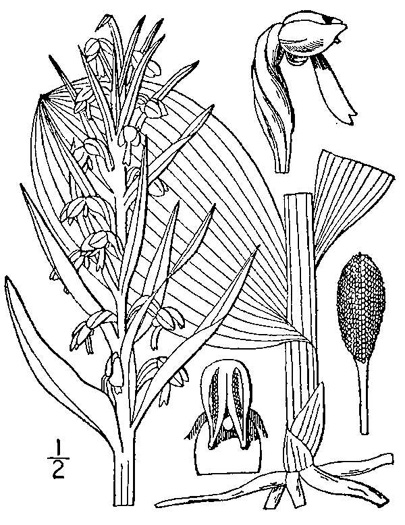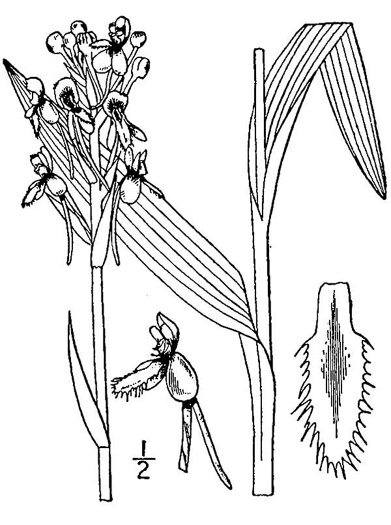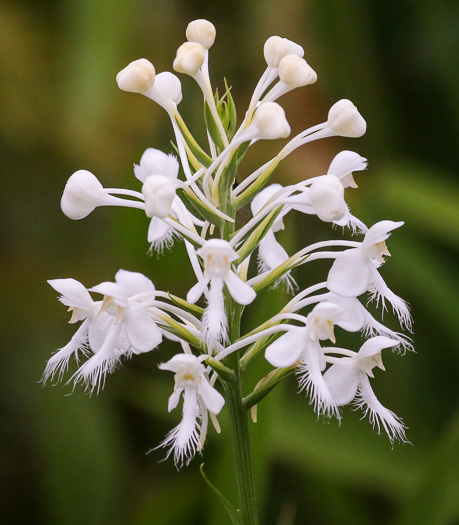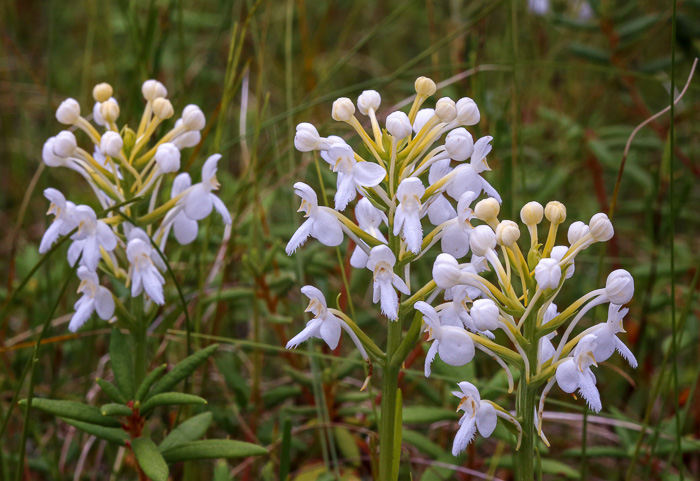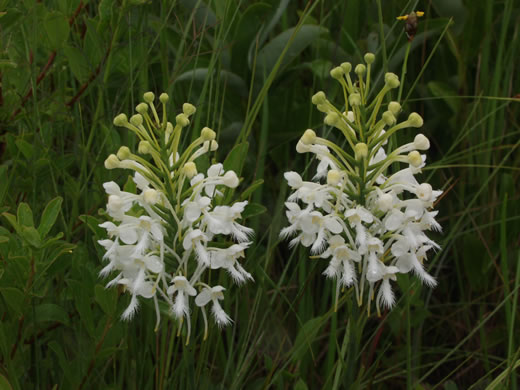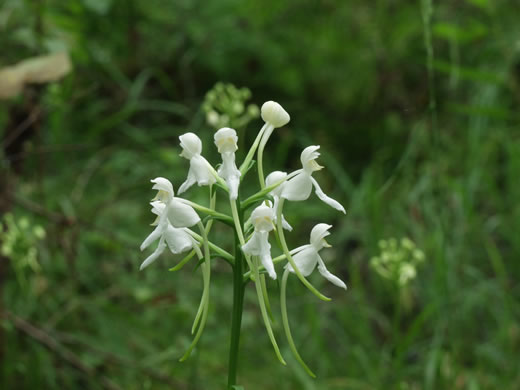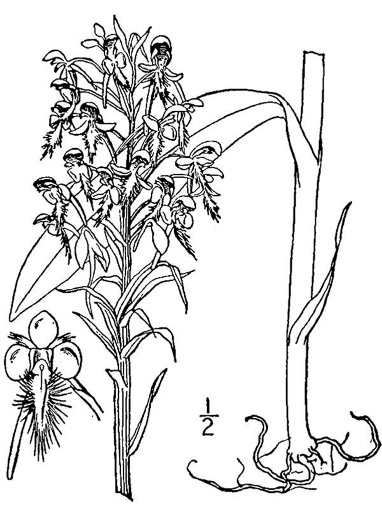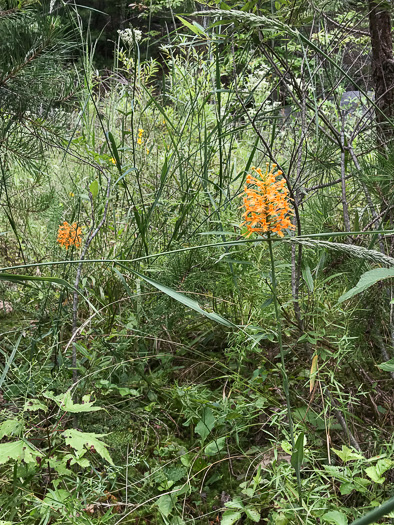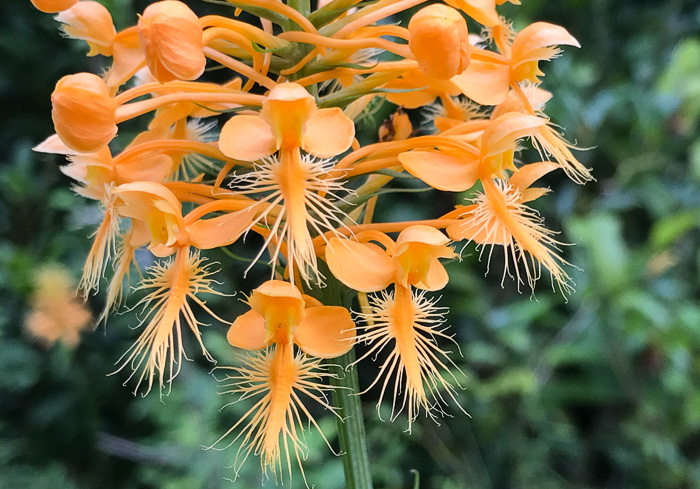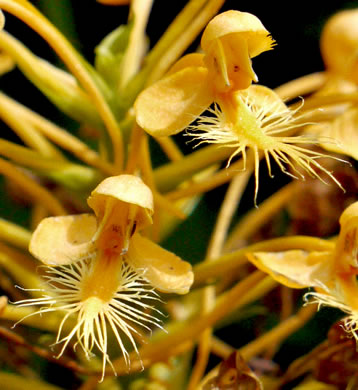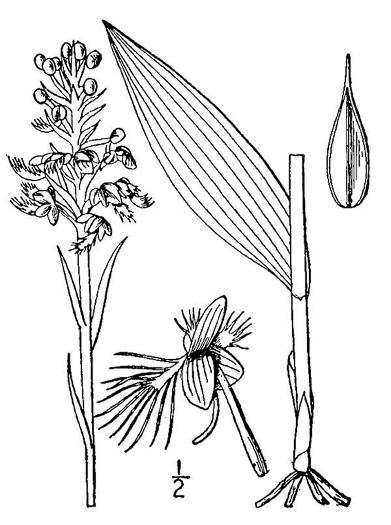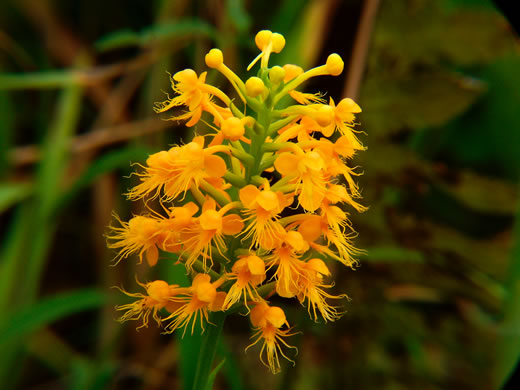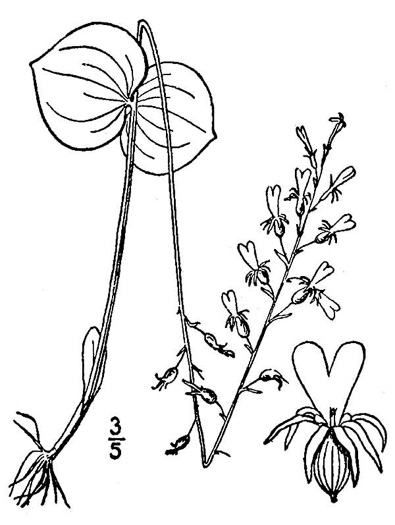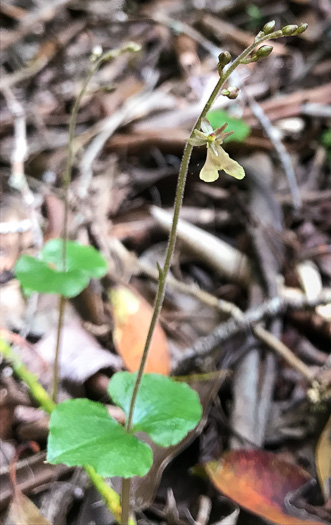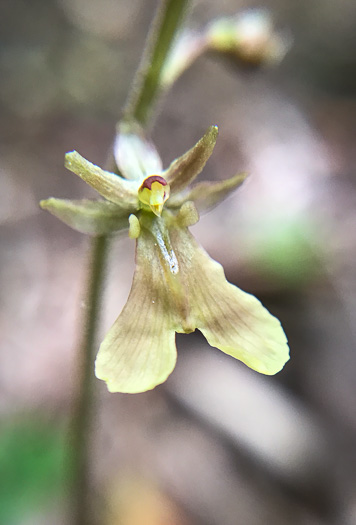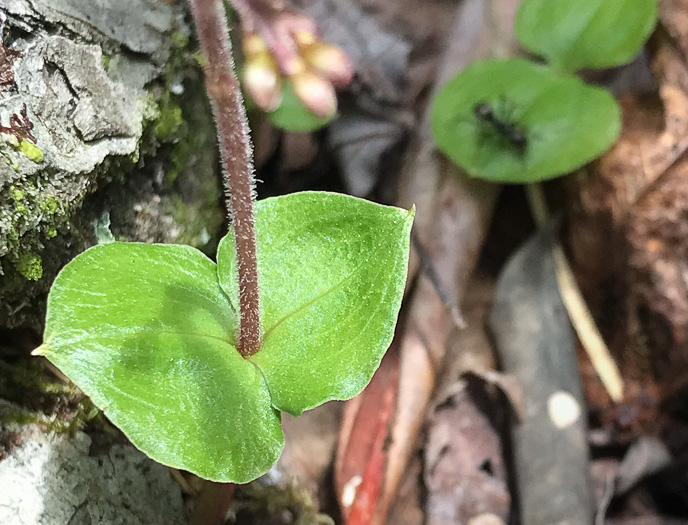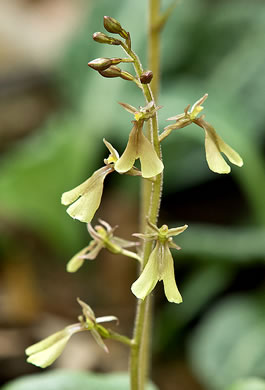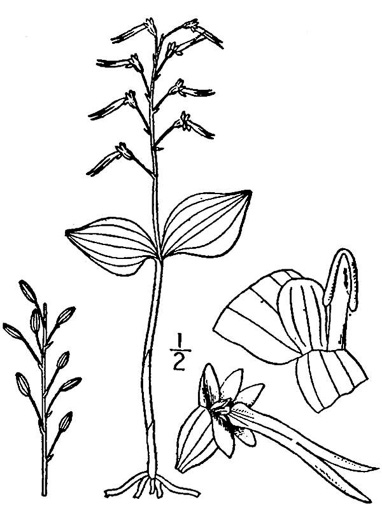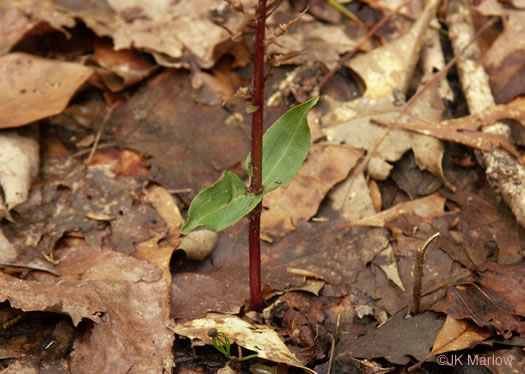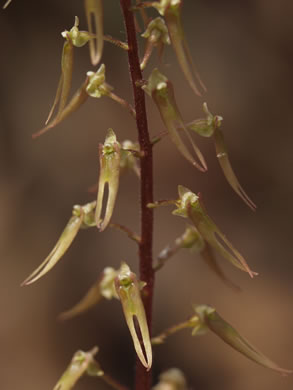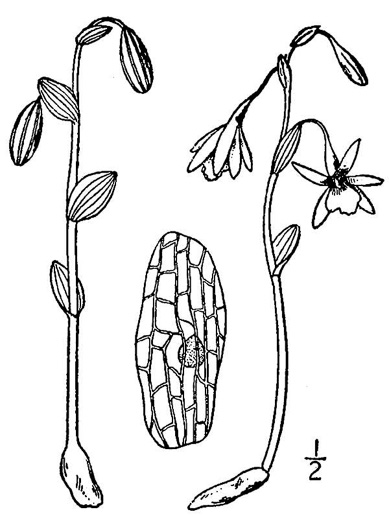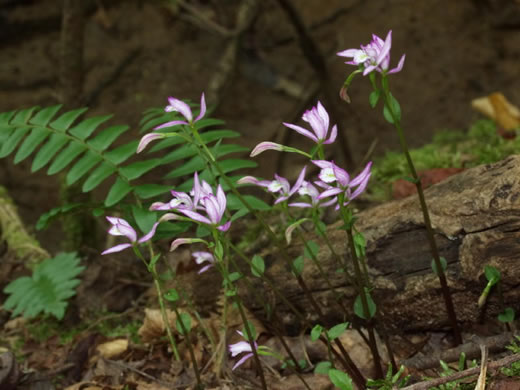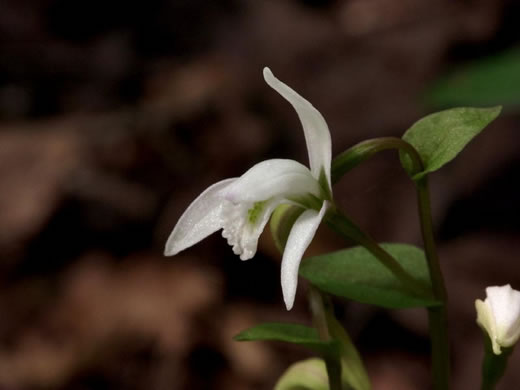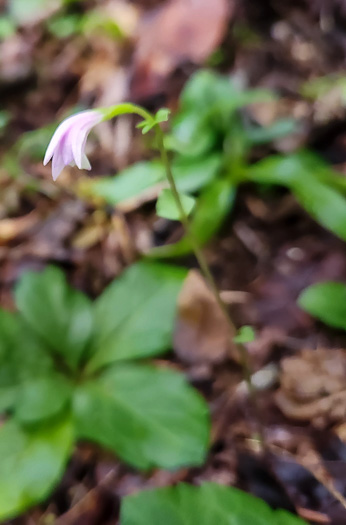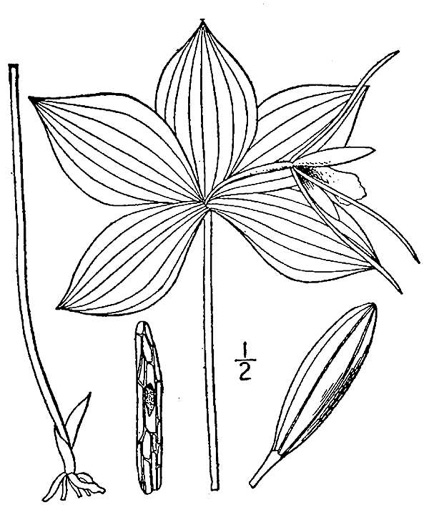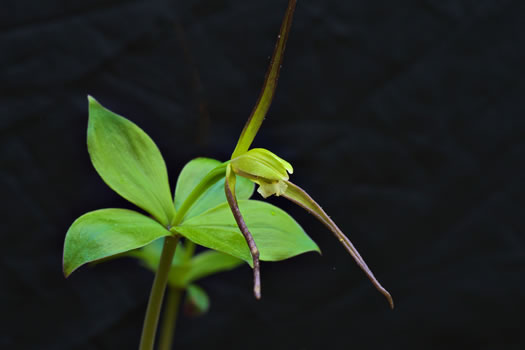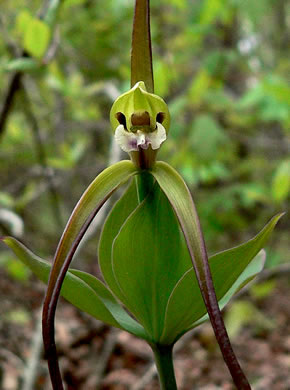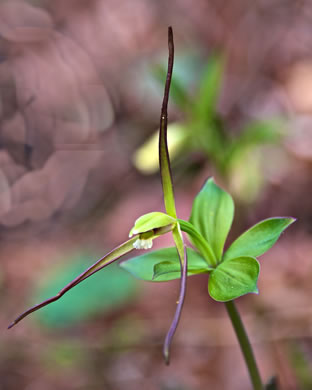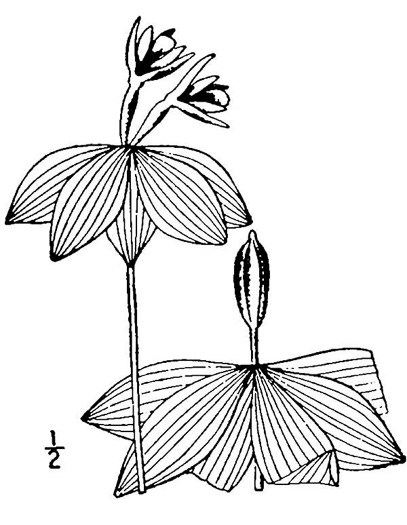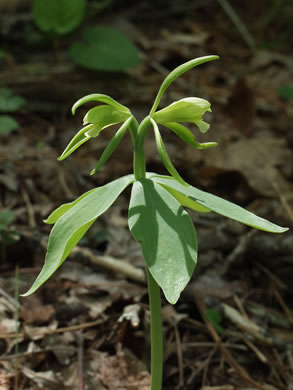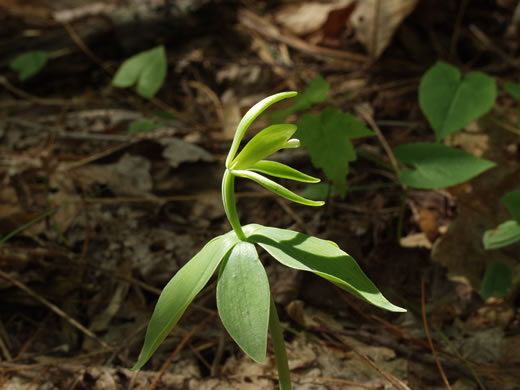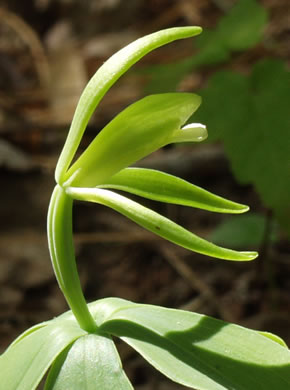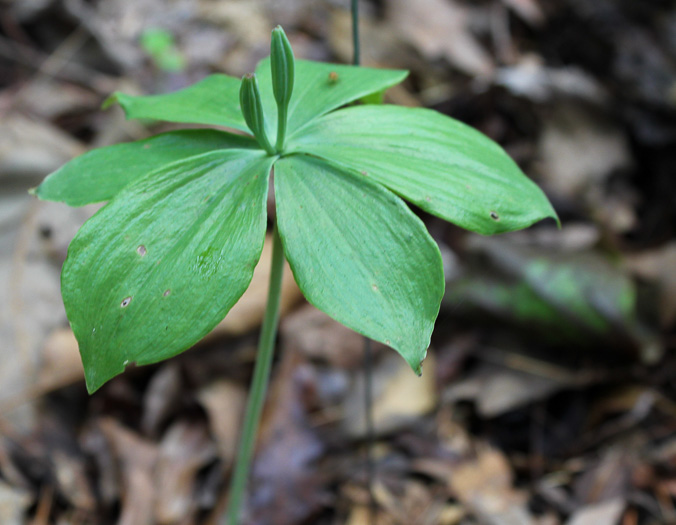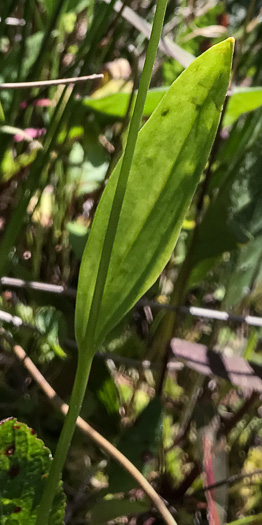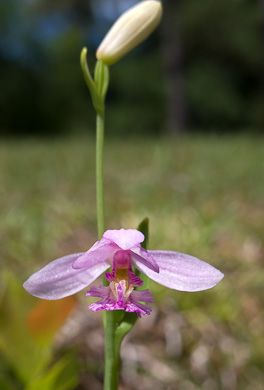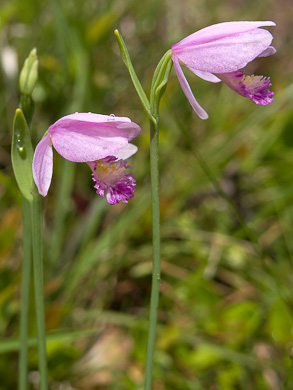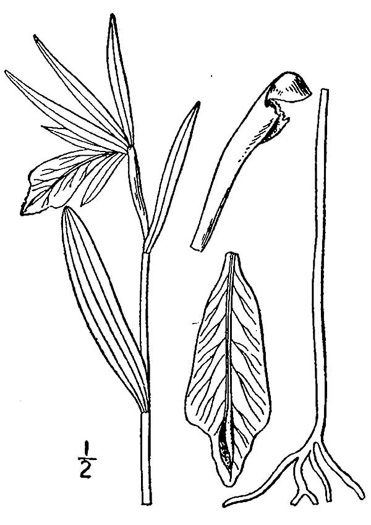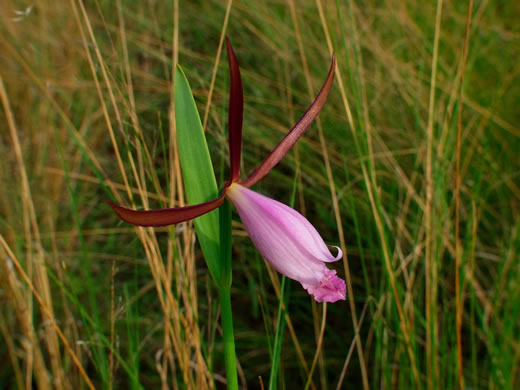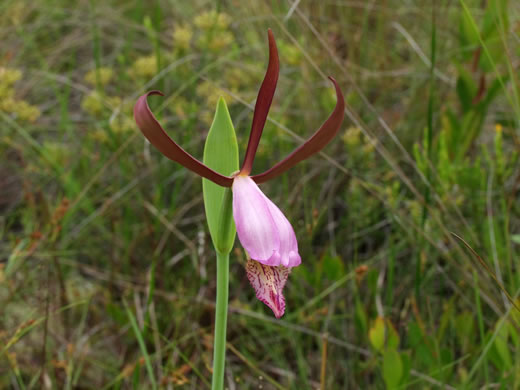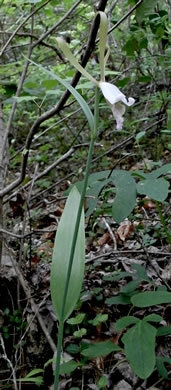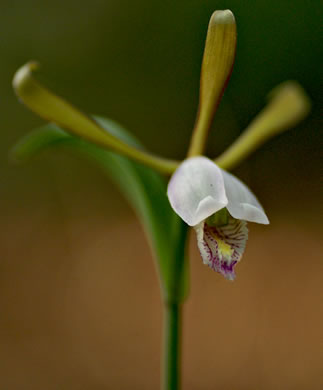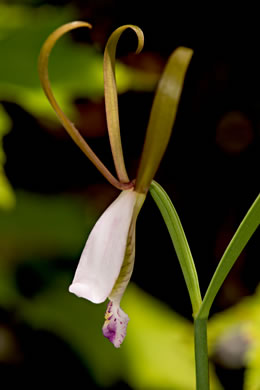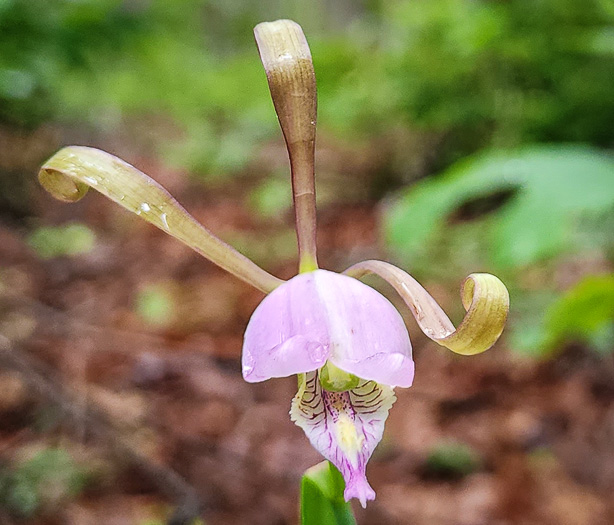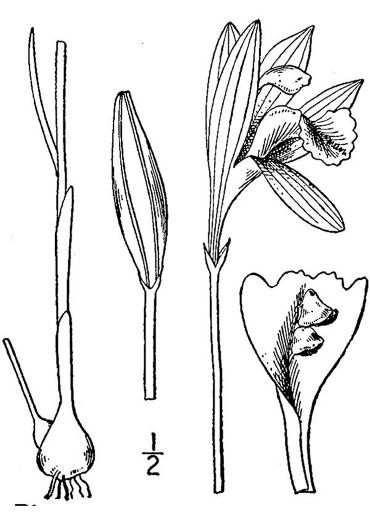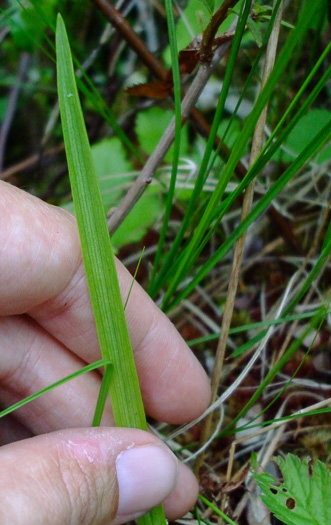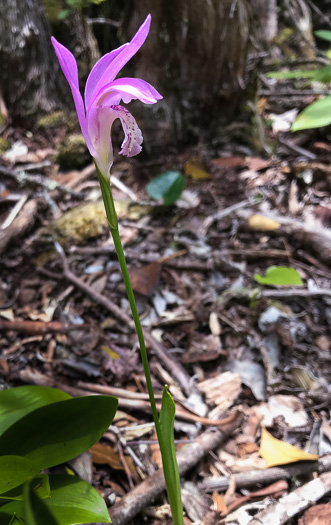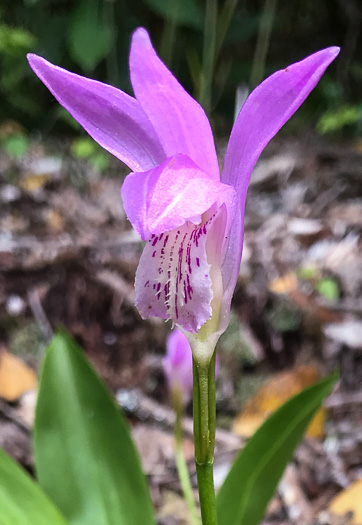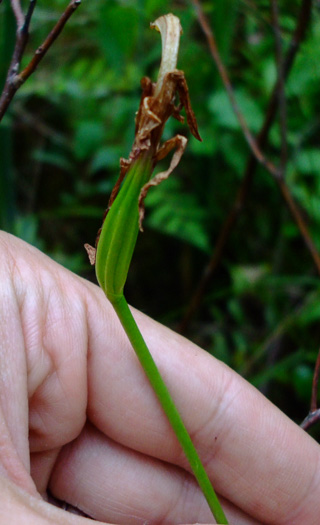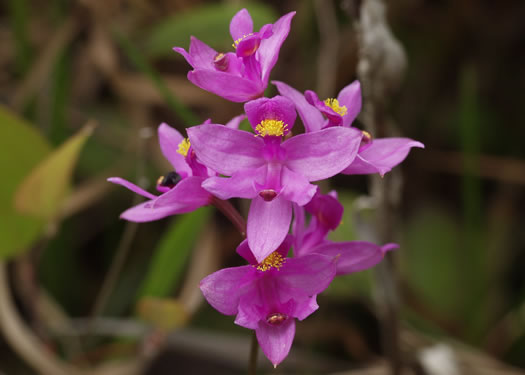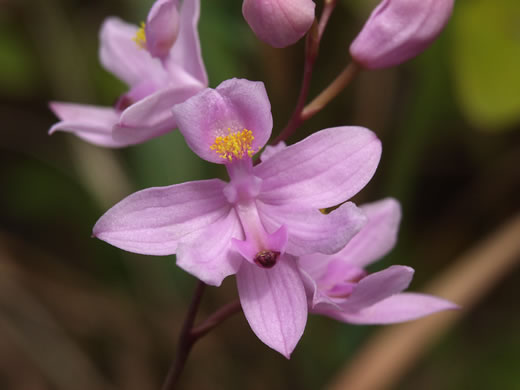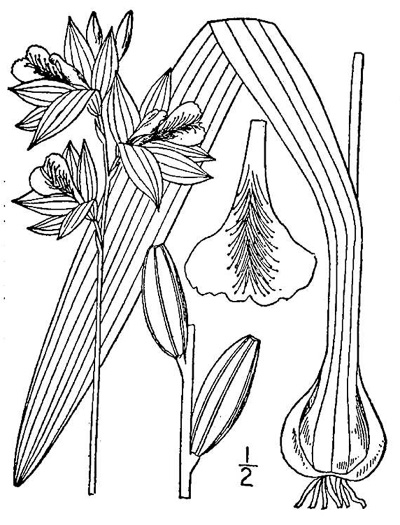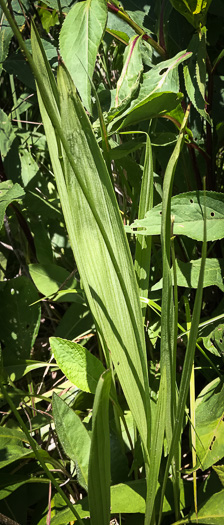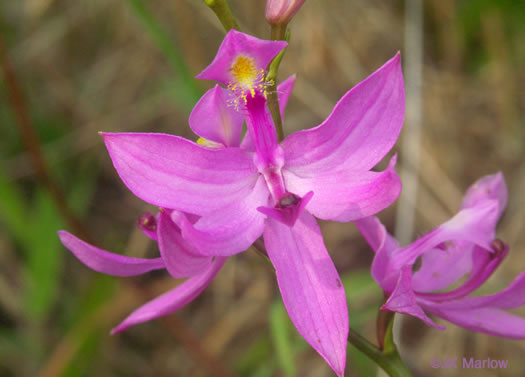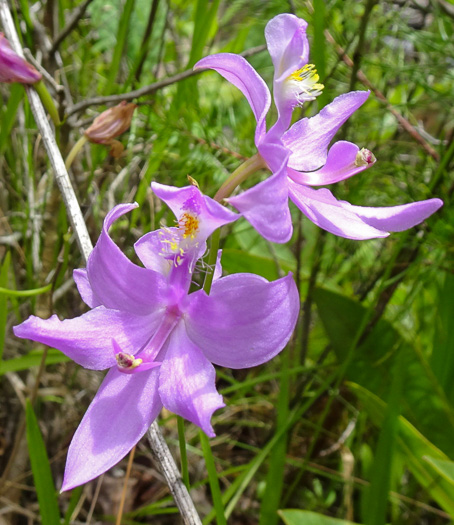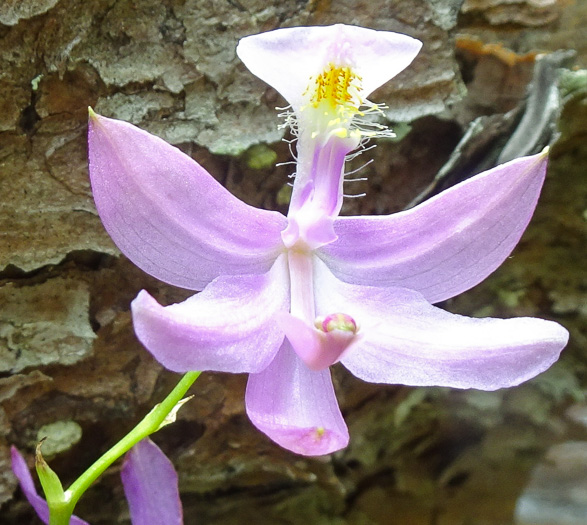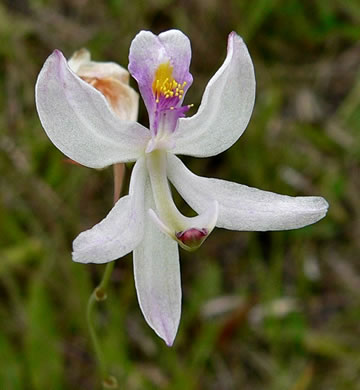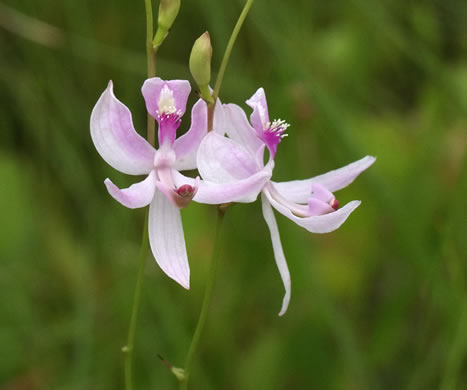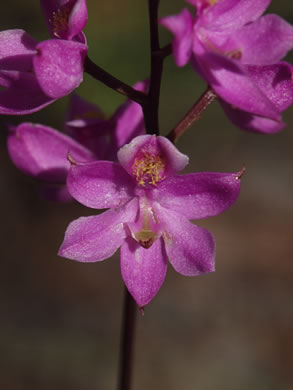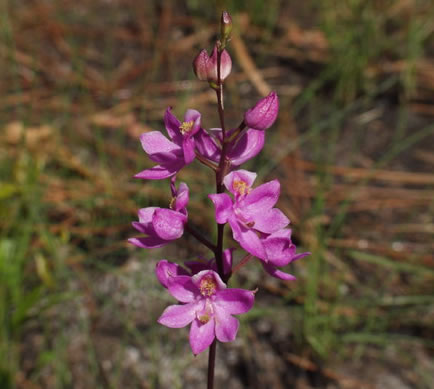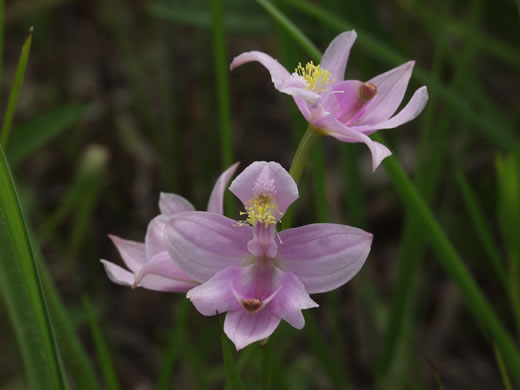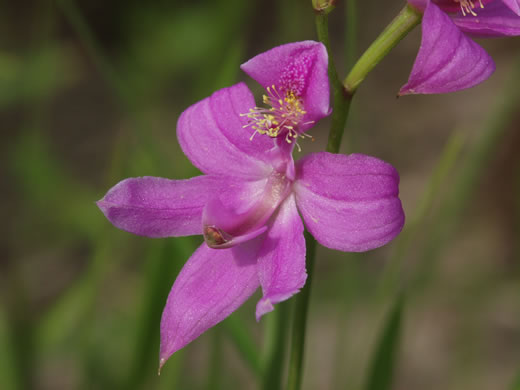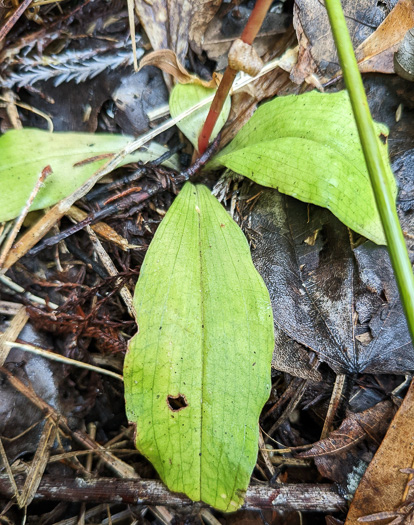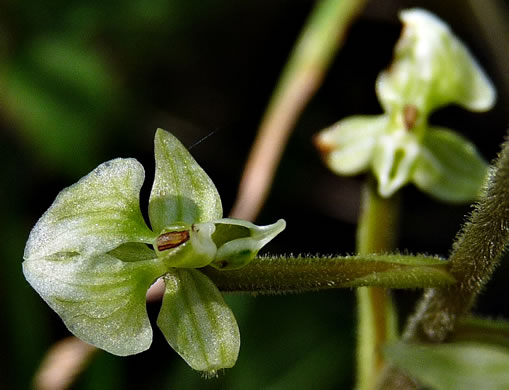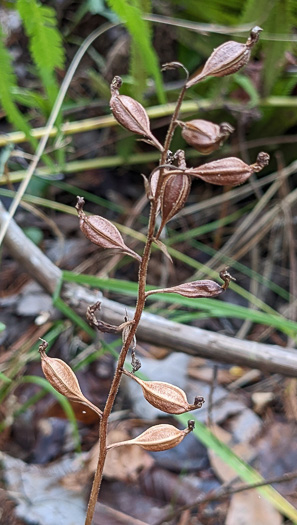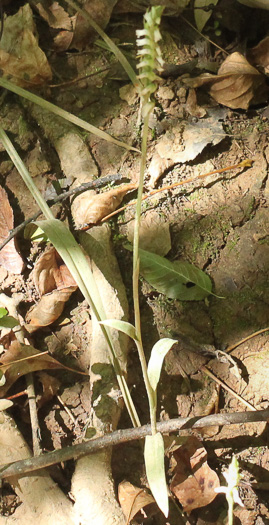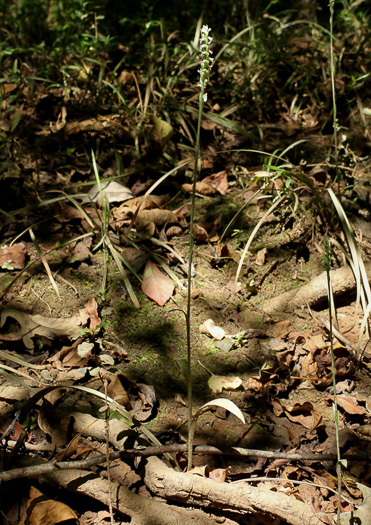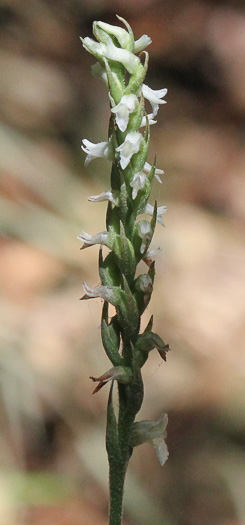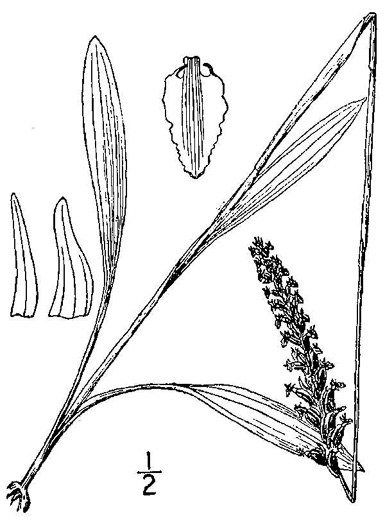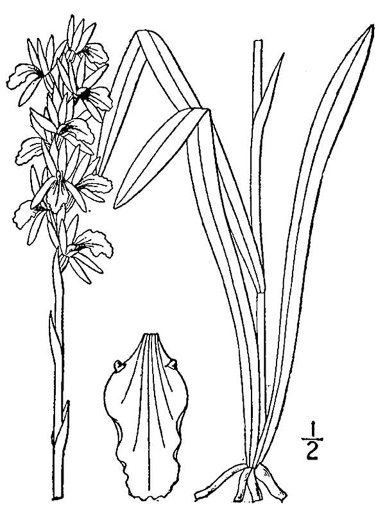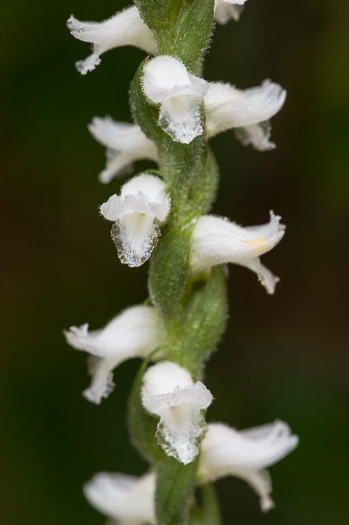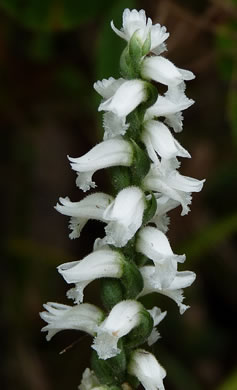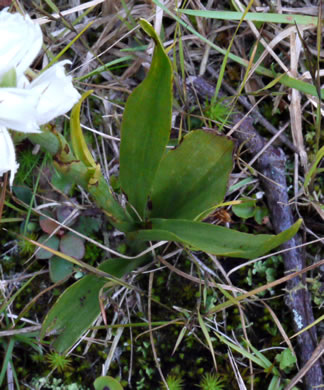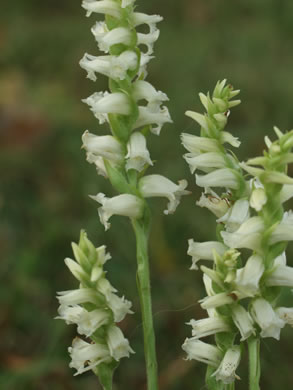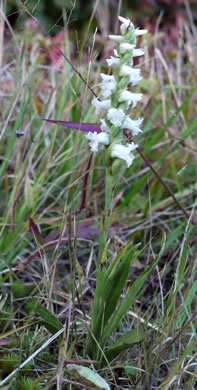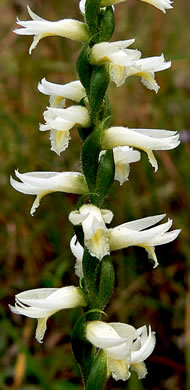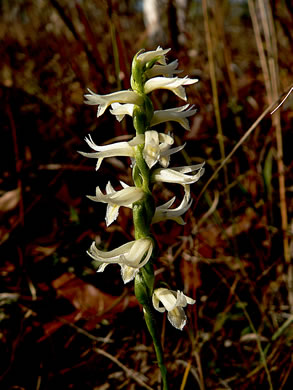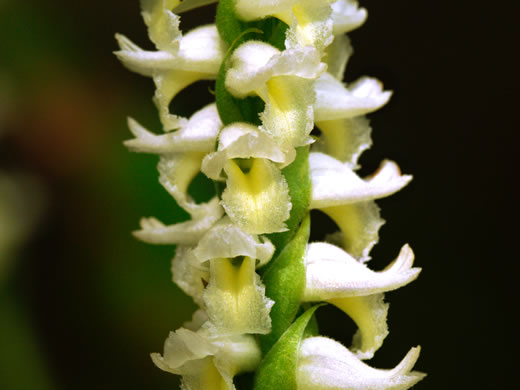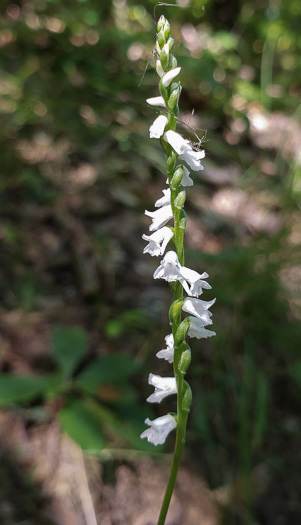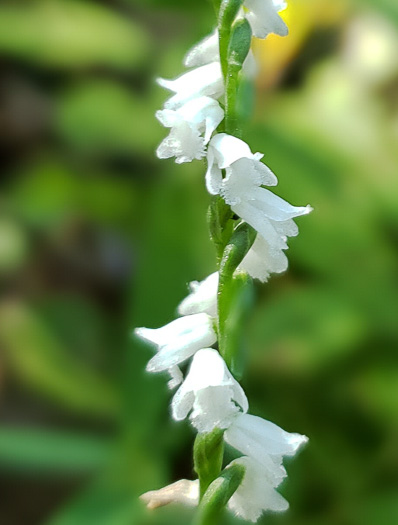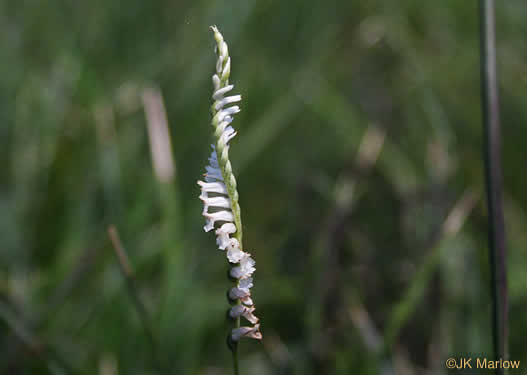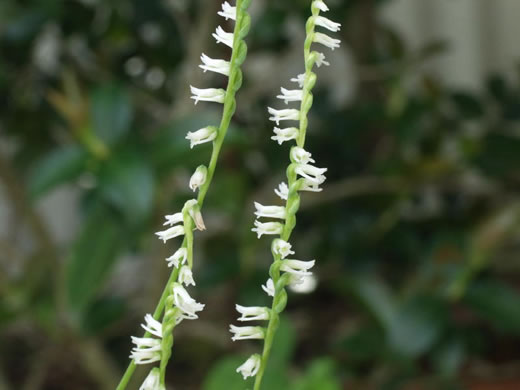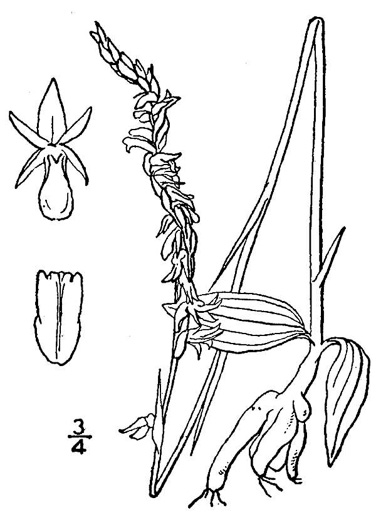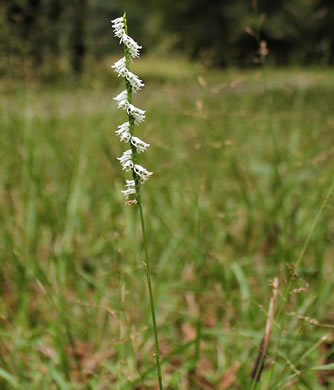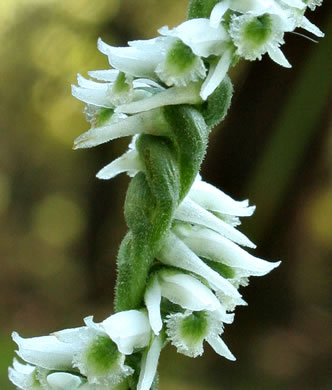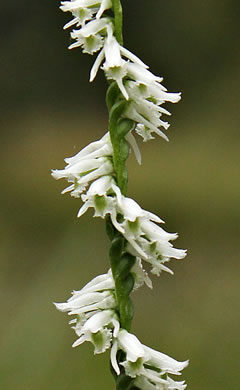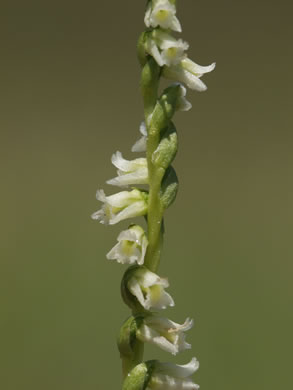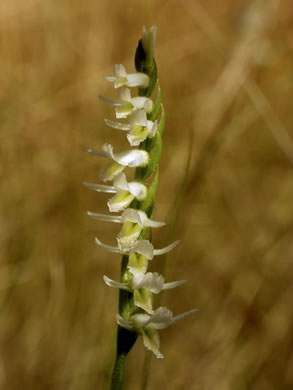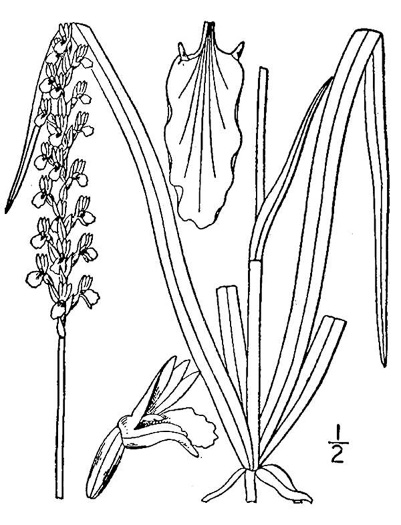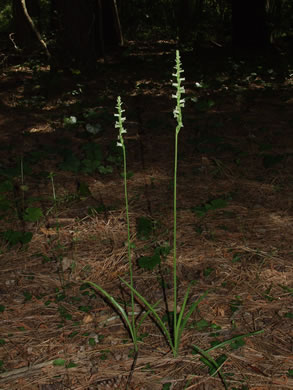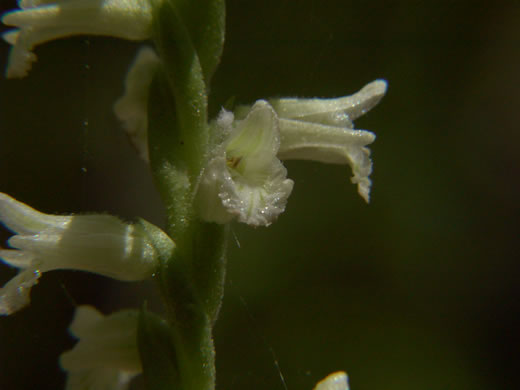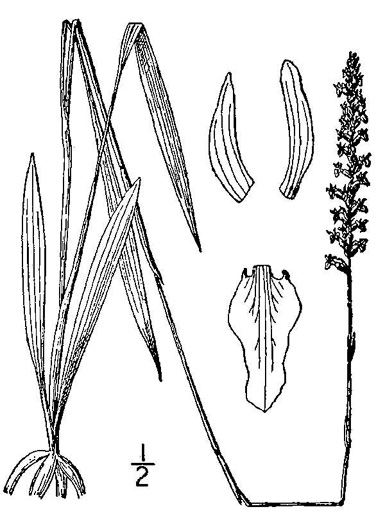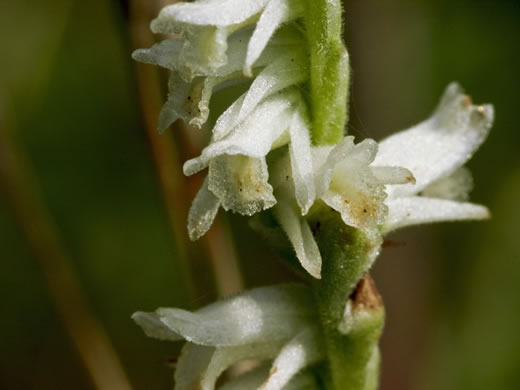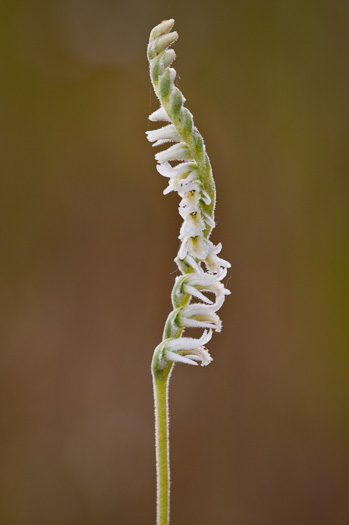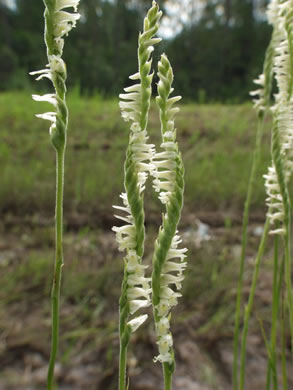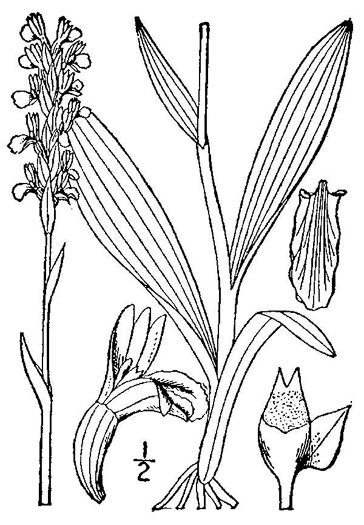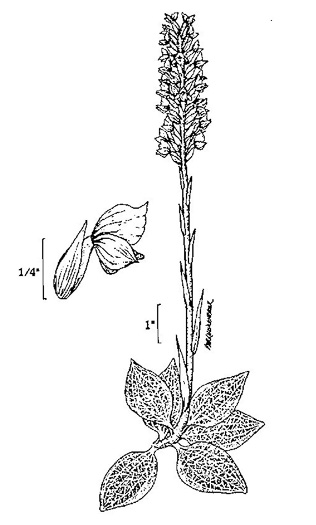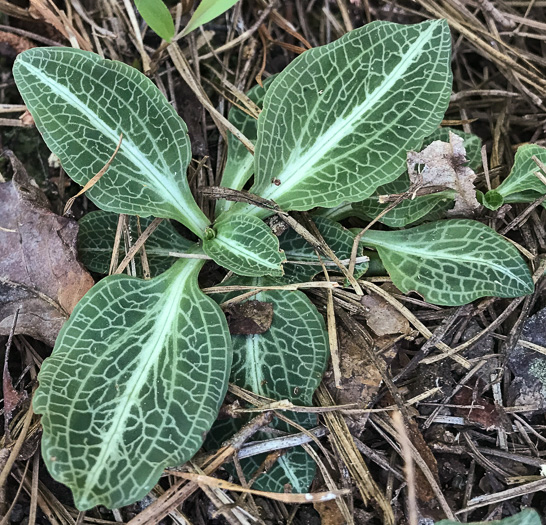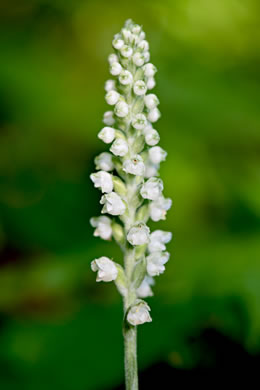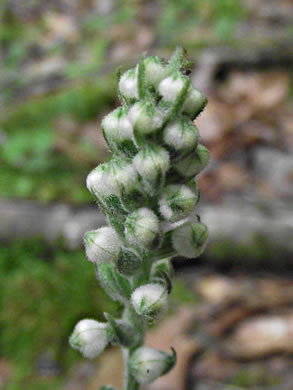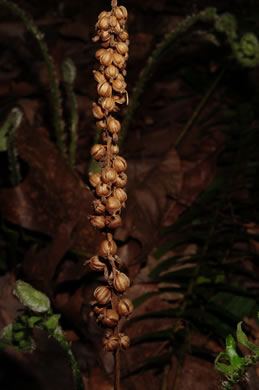Hovering over an image will enlarge it and point out features (works better on desktop than on mobile).
![]() A camera indicates there are pictures.
A camera indicates there are pictures.
![]() A speaker indicates that a botanical name is pronounced.
A speaker indicates that a botanical name is pronounced.
![]() A plus sign after a Latin name indicates that the species is further divided into varieties or subspecies.
A plus sign after a Latin name indicates that the species is further divided into varieties or subspecies.
Most habitat and range descriptions were obtained from Weakley's Flora.
Your search found 74 taxa in the family Orchidaceae, Orchid family, as understood by Vascular Flora of the Carolinas.

![]()
![]() Common Name:
Pink Lady's Slipper, Mocassin Flower
Common Name:
Pink Lady's Slipper, Mocassin Flower
Weakley's Flora: (4/24/22) Cypripedium acaule FAMILY: Orchidaceae
SYNONYMOUS WITH PLANTS National Database: Cypripedium acaule FAMILY: Orchidaceae
SYNONYMOUS WITH Vascular Flora of the Carolinas (Radford, Ahles, & Bell, 1968): Cypripedium acaule 049-01-001 FAMILY: Orchidaceae
Habitat: Dry to mesic, acid forests and woodlands, often under pine, other conifers, and/or oaks
Common (uncommon in Piedmont of GA & SC) (rare in Coastal Plain of GA & SC)
Native to the Carolinas & Georgia

![]()
![]() Common Name:
Large Yellow Lady's Slipper
Common Name:
Large Yellow Lady's Slipper
Weakley's Flora: (4/24/22) Cypripedium parviflorum var. pubescens FAMILY: Orchidaceae
SYNONYMOUS WITH PLANTS National Database: Cypripedium parviflorum var. pubescens FAMILY: Orchidaceae
INCLUDED WITHIN Vascular Flora of the Carolinas (Radford, Ahles, & Bell, 1968): Cypripedium calceolus var. pubescens 049-01-002 FAMILY: Orchidaceae
Habitat: Rich mesic forests
Uncommon
Native to the Carolinas & Georgia

![]() Common Name:
Small Yellow Lady's Slipper
Common Name:
Small Yellow Lady's Slipper
Weakley's Flora: (4/24/22) Cypripedium parviflorum var. parviflorum FAMILY: Orchidaceae
SYNONYMOUS WITH PLANTS National Database: Cypripedium parviflorum var. parviflorum FAMILY: Orchidaceae
INCLUDED WITHIN Vascular Flora of the Carolinas (Radford, Ahles, & Bell, 1968): Cypripedium calceolus var. pubescens 049-01-002? FAMILY: Orchidaceae
Habitat: Mesic forests, seepy forests over amphibolite, other habitats
Rare
Native to North Carolina & Georgia

![]() Common Name:
Kentucky Yellow Lady's Slipper
Common Name:
Kentucky Yellow Lady's Slipper
Weakley's Flora: (4/24/22) Cypripedium kentuckiense FAMILY: Orchidaceae
SYNONYMOUS WITH PLANTS National Database: Cypripedium kentuckiense FAMILY: Orchidaceae
Habitat: Sandy ravine bottoms and springhead seeps along small streams
Rare
Native to Georgia

![]()
![]() Common Name:
Showy Lady's Slipper, Queen Lady's Slipper
Common Name:
Showy Lady's Slipper, Queen Lady's Slipper
Weakley's Flora: (4/24/22) Cypripedium reginae FAMILY: Orchidaceae
SYNONYMOUS WITH PLANTS National Database: Cypripedium reginae FAMILY: Orchidaceae
SYNONYMOUS WITH Vascular Flora of the Carolinas (Radford, Ahles, & Bell, 1968): Cypripedium reginae 049-01-003 FAMILY: Orchidaceae
Habitat: Fens, seepage swamps, and mesic forests, over circumneutral to basic rocks
Rare (historically in NC Mountains, but not recently seen)
Native: north of the Carolinas & Georgia (doubtfully to NC)

![]() Common Name:
White Lady's Slipper
Common Name:
White Lady's Slipper
Weakley's Flora: (4/24/22) Cypripedium candidum FAMILY: Orchidaceae
SYNONYMOUS WITH PLANTS National Database: Cypripedium candidum FAMILY: Orchidaceae
Habitat: Calcareous barrens, bluffs, and fens
Native: north of the Carolinas

![]()
![]() Common Name:
Showy Orchis
Common Name:
Showy Orchis
Weakley's Flora: (4/24/22) Galearis spectabilis FAMILY: Orchidaceae
SYNONYMOUS WITH PLANTS National Database: Galearis spectabilis FAMILY: Orchidaceae
SYNONYMOUS WITH Vascular Flora of the Carolinas (Radford, Ahles, & Bell, 1968): Orchis spectabilis 049-02-001 FAMILY: Orchidaceae
Habitat: Rich, deciduous forests, most typically over calcareous or mafic rocks
Common in Mountains of GA & NC, uncommon SC Mountains, rare elsewhere in Carolinas
Native to the Carolinas & Georgia

![]()
![]() Common Name:
Ragged Fringed Orchid, Green Fringed Orchid, Ragged Orchid
Common Name:
Ragged Fringed Orchid, Green Fringed Orchid, Ragged Orchid
Weakley's Flora: (4/24/22) Platanthera lacera FAMILY: Orchidaceae
SYNONYMOUS WITH PLANTS National Database: Platanthera lacera FAMILY: Orchidaceae
SYNONYMOUS WITH Vascular Flora of the Carolinas (Radford, Ahles, & Bell, 1968): Habenaria lacera 049-03-001 FAMILY: Orchidaceae
Habitat: Swamps, bogs, seepages, marshes
Rare
Native to the Carolinas & Georgia

![]()
![]() Common Name:
Small Purple Fringed Orchid, Butterfly Orchid, Lesser Purple Fringed Orchid
Common Name:
Small Purple Fringed Orchid, Butterfly Orchid, Lesser Purple Fringed Orchid
Weakley's Flora: (4/24/22) Platanthera psycodes FAMILY: Orchidaceae
SYNONYMOUS WITH PLANTS National Database: Platanthera psycodes FAMILY: Orchidaceae
SYNONYMOUS WITH Vascular Flora of the Carolinas (Radford, Ahles, & Bell, 1968): Habenaria psycodes var. psycodes 049-03-003a FAMILY: Orchidaceae
Habitat: Northern hardwood forests, other moist forests, seepages, bogs
Uncommon (rare in GA)
Native to the Carolinas & Georgia

![]()
![]() Common Name:
Large Purple Fringed Orchid, Plume-royal, Greater Purple Fringed Orchid
Common Name:
Large Purple Fringed Orchid, Plume-royal, Greater Purple Fringed Orchid
Weakley's Flora: (4/24/22) Platanthera grandiflora FAMILY: Orchidaceae
INCLUDED WITHIN PLANTS National Database: Platanthera grandiflora FAMILY: Orchidaceae
INCLUDED WITHIN Vascular Flora of the Carolinas (Radford, Ahles, & Bell, 1968): Habenaria psycodes var. grandiflora 049-03-003b FAMILY: Orchidaceae
Habitat: Bogs, seepages, moist places at high elevations
Rare
Native to North Carolina & Georgia

![]()
![]() Common Name:
Purple Fringeless Orchid, Purple Spire Orchid, Pride-of-the-peak
Common Name:
Purple Fringeless Orchid, Purple Spire Orchid, Pride-of-the-peak
Weakley's Flora: (4/24/22) Platanthera peramoena FAMILY: Orchidaceae
SYNONYMOUS WITH PLANTS National Database: Platanthera peramoena FAMILY: Orchidaceae
SYNONYMOUS WITH Vascular Flora of the Carolinas (Radford, Ahles, & Bell, 1968): Habenaria peramoena 049-03-004 FAMILY: Orchidaceae
Habitat: Bogs, seepages, moist forests, moist meadows
Rare (historically in SC, but not recently seen)
Native to the Carolinas & Georgia

![]()
![]() Common Name:
Michaux's Orchid, Long-horned Habenaria
Common Name:
Michaux's Orchid, Long-horned Habenaria
Weakley's Flora: (4/24/22) Habenaria quinqueseta FAMILY: Orchidaceae
SYNONYMOUS WITH PLANTS National Database: Habenaria quinqueseta FAMILY: Orchidaceae
INCLUDED WITHIN Vascular Flora of the Carolinas (Radford, Ahles, & Bell, 1968): Habenaria quinqueseta 049-03-005 FAMILY: Orchidaceae
Habitat: Wet to mesic pine flatwoods, moist hardwood hammocks, Altamaha Grit outcrops, pine rocklands, ditches
Rare
Native to South Carolina & Georgia

![]()
![]() Common Name:
Water-spider Orchid, Floating Orchid
Common Name:
Water-spider Orchid, Floating Orchid
Weakley's Flora: (4/24/22) Habenaria repens FAMILY: Orchidaceae
SYNONYMOUS WITH PLANTS National Database: Habenaria repens FAMILY: Orchidaceae
SYNONYMOUS WITH Vascular Flora of the Carolinas (Radford, Ahles, & Bell, 1968): Habenaria repens 049-03-006 FAMILY: Orchidaceae
Habitat: Blackwater swamps, pools, banks of creeks and rivers, marshes
Uncommon (rare in NC)
Native to the Carolinas & Georgia

![]() Common Name:
Large Round-leaved Orchid, Dessert-plate Orchid
Common Name:
Large Round-leaved Orchid, Dessert-plate Orchid
Weakley's Flora: (4/24/22) Platanthera orbiculata FAMILY: Orchidaceae
SYNONYMOUS WITH PLANTS National Database: Platanthera orbiculata FAMILY: Orchidaceae
INCLUDED WITHIN Vascular Flora of the Carolinas (Radford, Ahles, & Bell, 1968): Habenaria orbiculata 049-03-007 FAMILY: Orchidaceae
Habitat: Moist hardwood forests and seeps, especially over mafic, calcareous, or other more nutrient-rich substrates
Uncommon in NC Mountains, rare in NC Piedmont
Native to North Carolina

![]()
![]() Common Name:
Yellow Fringeless Orchid, Golden Frog Orchid, Golden Fringeless Orchid, Golden Frog Arrow
Common Name:
Yellow Fringeless Orchid, Golden Frog Orchid, Golden Fringeless Orchid, Golden Frog Arrow
Weakley's Flora: (4/24/22) Platanthera integra FAMILY: Orchidaceae
SYNONYMOUS WITH PLANTS National Database: Platanthera integra FAMILY: Orchidaceae
SYNONYMOUS WITH Vascular Flora of the Carolinas (Radford, Ahles, & Bell, 1968): Habenaria integra 049-03-008 FAMILY: Orchidaceae
Habitat: Wet pine savannas in the Coastal Plain, bogs in the Mountains and Piedmont
Rare in Coastal Plain (historically in NC Mountains & NC Piedmont, but not recently seen)
Native to the Carolinas & Georgia

![]()
![]() Common Name:
Snowy Orchid, Bog-spike
Common Name:
Snowy Orchid, Bog-spike
Weakley's Flora: (4/24/22) Platanthera nivea FAMILY: Orchidaceae
SYNONYMOUS WITH PLANTS National Database: Platanthera nivea FAMILY: Orchidaceae
SYNONYMOUS WITH Vascular Flora of the Carolinas (Radford, Ahles, & Bell, 1968): Habenaria nivea 049-03-009 FAMILY: Orchidaceae
Habitat: Wet pine savannas, acid seepages, Catahoula barrens (in e. TX)
Rare
Native to the Carolinas & Georgia

![]()
![]() Common Name:
Southern Rein Orchid, Southern Gypsy-spike
Common Name:
Southern Rein Orchid, Southern Gypsy-spike
Weakley's Flora: (4/14/23) Platanthera flava var. flava FAMILY: Orchidaceae
SYNONYMOUS WITH PLANTS National Database: Platanthera flava var. flava FAMILY: Orchidaceae
SYNONYMOUS WITH Vascular Flora of the Carolinas (Radford, Ahles, & Bell, 1968): Habenaria flava var. flava 049-03-010a FAMILY: Orchidaceae
Habitat: Shaded wet places, such as swampy forests
Uncommon in Coastal Plain, rare in Piedmont
Native to the Carolinas & Georgia

Common Name: Tubercled Rein Orchid, Northern Gypsy-spike
Weakley's Flora: (4/14/23) Platanthera flava var. herbiola FAMILY: Orchidaceae
SYNONYMOUS WITH PLANTS National Database: Platanthera flava var. herbiola FAMILY: Orchidaceae
SYNONYMOUS WITH Vascular Flora of the Carolinas (Radford, Ahles, & Bell, 1968): Habenaria flava var. herbiola 049-03-010b FAMILY: Orchidaceae
Habitat: Bogs, seepages
Rare
Native to North Carolina & Georgia

![]()
![]() Common Name:
Small Green Wood Orchid, Club-spur Orchid, Woodland Orchid, Streamhead Orchid
Common Name:
Small Green Wood Orchid, Club-spur Orchid, Woodland Orchid, Streamhead Orchid
Weakley's Flora: (4/24/22) Platanthera clavellata FAMILY: Orchidaceae
SYNONYMOUS WITH PLANTS National Database: Platanthera clavellata FAMILY: Orchidaceae
INCLUDING Vascular Flora of the Carolinas (Radford, Ahles, & Bell, 1968): Habenaria clavellata var. clavellata 049-03-011 FAMILY: Orchidaceae
Habitat: Seepages, bogs, swamps, other wet places
Common (uncommon in Piedmont, rare in GA Coastal Plain)
Native to the Carolinas & Georgia

Common Name: Longbract Frog Orchid, Long-bracted Orchid
Weakley's Flora: (4/24/22) Dactylorhiza viridis FAMILY: Orchidaceae
SYNONYMOUS WITH PLANTS National Database: Dactylorhiza viridis FAMILY: Orchidaceae
INCLUDING Vascular Flora of the Carolinas (Radford, Ahles, & Bell, 1968): Habenaria viridis var. bracteata 049-03-012 FAMILY: Orchidaceae
Habitat: Moist forests
Rare
Native to North Carolina

![]()
![]() Common Name:
Small White Fringed Orchid
Common Name:
Small White Fringed Orchid
Weakley's Flora: (4/24/22) Platanthera blephariglottis FAMILY: Orchidaceae
SYNONYMOUS WITH PLANTS National Database: Platanthera blephariglottis var. blephariglottis FAMILY: Orchidaceae
INCLUDED WITHIN (POSSIBLY MISAPPLIED) Vascular Flora of the Carolinas (Radford, Ahles, & Bell, 1968): Habenaria blephariglottis var. blephariglottis 049-03-013a FAMILY: Orchidaceae
Habitat: Seepages, sandhill-pocosin ecotones
Uncommon in Carolina Coastal Plain (rare elsewhere in GA-NC-SC)
Native to the Carolinas & Georgia

![]()
![]() Common Name:
Large White Fringed Orchid, Southern White Fringed Orchid
Common Name:
Large White Fringed Orchid, Southern White Fringed Orchid
Weakley's Flora: (4/24/22) Platanthera conspicua FAMILY: Orchidaceae
SYNONYMOUS WITH PLANTS National Database: Platanthera blephariglottis var. conspicua FAMILY: Orchidaceae
INCLUDED WITHIN Vascular Flora of the Carolinas (Radford, Ahles, & Bell, 1968): Habenaria blephariglottis var. blephariglottis 049-03-013a? FAMILY: Orchidaceae
Habitat: Pine savannas, seepages, longleaf pine sandhill-pocosin ecotones
Uncommon
Native to the Carolinas & Georgia

![]()
![]() Common Name:
Monkey-face Orchid, White Fringeless Orchid
Common Name:
Monkey-face Orchid, White Fringeless Orchid
Weakley's Flora: (4/24/22) Platanthera integrilabia FAMILY: Orchidaceae
SYNONYMOUS WITH PLANTS National Database: Platanthera integrilabia FAMILY: Orchidaceae
SYNONYMOUS WITH Vascular Flora of the Carolinas (Radford, Ahles, & Bell, 1968): Habenaria blephariglottis var. integrilabia 049-03-013b? FAMILY: Orchidaceae
Habitat: Bogs, red maple-gum swamps, seeps, and streambanks
Rare (historically in NC, but not recently seen)
Native to the Carolinas & Georgia

![]()
![]() Common Name:
Yellow Fringed Orchid
Common Name:
Yellow Fringed Orchid
Weakley's Flora: (4/24/22) Platanthera ciliaris FAMILY: Orchidaceae
SYNONYMOUS WITH PLANTS National Database: Platanthera ciliaris FAMILY: Orchidaceae
SYNONYMOUS WITH Vascular Flora of the Carolinas (Radford, Ahles, & Bell, 1968): Habenaria ciliaris 049-03-014 FAMILY: Orchidaceae
Habitat: Pine savannas, moist roadbanks, meadows, pastures, bogs, marshes
Common (uncommon in GA Coastal Plain) (rare in Piedmont)
Native to the Carolinas & Georgia

![]()
![]() Common Name:
Crested Fringed Orchid, Golden Fringed Orchid
Common Name:
Crested Fringed Orchid, Golden Fringed Orchid
Weakley's Flora: (4/24/22) Platanthera cristata FAMILY: Orchidaceae
SYNONYMOUS WITH PLANTS National Database: Platanthera cristata FAMILY: Orchidaceae
SYNONYMOUS WITH Vascular Flora of the Carolinas (Radford, Ahles, & Bell, 1968): Habenaria cristata 049-03-015 FAMILY: Orchidaceae
Habitat: Pine savannas, bogs, moist roadsides
Uncommon in Coastal Plain (rare elsewhere in GA-NC-SC)
Native to the Carolinas & Georgia

![]()
![]() Common Name:
Kidneyleaf Twayblade, Appalachian Twayblade, Small's Twayblade
Common Name:
Kidneyleaf Twayblade, Appalachian Twayblade, Small's Twayblade
Weakley's Flora: (4/24/22) Neottia smallii FAMILY: Orchidaceae
SYNONYMOUS WITH PLANTS National Database: Listera smallii FAMILY: Orchidaceae
SYNONYMOUS WITH Vascular Flora of the Carolinas (Radford, Ahles, & Bell, 1968): Listera smallii 049-04-001 FAMILY: Orchidaceae
Habitat: Shaded swamps, wet slopes, nearly always beneath Rhododendron maximum
Uncommon in NC Mountains, rare in GA & SC
Native to the Carolinas & Georgia

![]()
![]() Common Name:
Southern Twayblade
Common Name:
Southern Twayblade
Weakley's Flora: (4/24/22) Neottia bifolia FAMILY: Orchidaceae
SYNONYMOUS WITH PLANTS National Database: Listera australis FAMILY: Orchidaceae
SYNONYMOUS WITH Vascular Flora of the Carolinas (Radford, Ahles, & Bell, 1968): Listera australis 049-04-003 FAMILY: Orchidaceae
Habitat: Swamps, second terraces in floodplain forests, wet woods under Rhododendron maximum, Coastal Plain bogs
Uncommon in Coastal Plain, rare elsewhere
Native to the Carolinas & Georgia

![]()
![]() Common Name:
Three Birds Orchid, Nodding Pogonia, Nodding Ettercap
Common Name:
Three Birds Orchid, Nodding Pogonia, Nodding Ettercap
Weakley's Flora: (4/24/22) Triphora trianthophoros var. trianthophoros FAMILY: Orchidaceae
INCLUDED WITHIN (ORTHOGRAPHIC VARIANT PLANTS National Database: Triphora trianthophora FAMILY: Orchidaceae
INCLUDED WITHIN (ORTHOGRAPHIC VARIANT Vascular Flora of the Carolinas (Radford, Ahles, & Bell, 1968): Triphora trianthophora 049-05-001 FAMILY: Orchidaceae
Habitat: Humid forests and swamps, rhododendron thickets, especially on rotten logs or on humus, in the mountains often under hemlock
Rare
Native to the Carolinas & Georgia

![]()
![]() Common Name:
Large Whorled Pogonia, Large Five-leaves
Common Name:
Large Whorled Pogonia, Large Five-leaves
Weakley's Flora: (4/24/22) Isotria verticillata FAMILY: Orchidaceae
SYNONYMOUS WITH PLANTS National Database: Isotria verticillata FAMILY: Orchidaceae
SYNONYMOUS WITH Vascular Flora of the Carolinas (Radford, Ahles, & Bell, 1968): Isotria verticillata 049-06-001 FAMILY: Orchidaceae
Habitat: Acidic, mesic to dry forests, less typically seeps and bogs
Rare
Native to the Carolinas & Georgia

![]()
![]() Common Name:
Small Whorled Pogonia, Little Five-leaves
Common Name:
Small Whorled Pogonia, Little Five-leaves
Weakley's Flora: (4/24/22) Isotria medeoloides FAMILY: Orchidaceae
SYNONYMOUS WITH PLANTS National Database: Isotria medeoloides FAMILY: Orchidaceae
SYNONYMOUS WITH Vascular Flora of the Carolinas (Radford, Ahles, & Bell, 1968): Isotria medeoloides 049-06-002 FAMILY: Orchidaceae
Habitat: Acidic mesic to dry-mesic forests, in the mountains and upper Piedmont usually with Pinus strobus
Rare
Native to the Carolinas & Georgia

![]()
![]() Common Name:
Rose Pogonia, Snakemouth Orchid, Beardflower, Addermouth
Common Name:
Rose Pogonia, Snakemouth Orchid, Beardflower, Addermouth
Weakley's Flora: (4/24/22) Pogonia ophioglossoides FAMILY: Orchidaceae
SYNONYMOUS WITH PLANTS National Database: Pogonia ophioglossoides FAMILY: Orchidaceae
SYNONYMOUS WITH Vascular Flora of the Carolinas (Radford, Ahles, & Bell, 1968): Pogonia ophioglossoides 049-07-001 FAMILY: Orchidaceae
Habitat: Savannas, bogs, especially in open peaty or gravelly situations with seepage
Uncommon in Coastal Plain, rare elsewhere
Native to the Carolinas & Georgia

![]()
![]() Common Name:
Large Dragonhead Pogonia, Rosebud Orchid, Large Spreading Pogonia
Common Name:
Large Dragonhead Pogonia, Rosebud Orchid, Large Spreading Pogonia
Weakley's Flora: (4/24/22) Cleistesiopsis divaricata FAMILY: Orchidaceae
INCLUDED WITHIN PLANTS National Database: Cleistes divaricata FAMILY: Orchidaceae
INCLUDED WITHIN Vascular Flora of the Carolinas (Radford, Ahles, & Bell, 1968): Cleistes divaricata 049-08-001 FAMILY: Orchidaceae
Habitat: Pine savannas, Coastal Plain seepage bogs
Uncommon in Carolina Coastal Plain, rare elsewhere
Native to the Carolinas & Georgia

![]()
![]() Common Name:
Appalachian Dragonhead Pogonia, Appalachian Small Spreading Pogonia, Smaller Rosebud Orchid, Upland Spreading Pogonia
Common Name:
Appalachian Dragonhead Pogonia, Appalachian Small Spreading Pogonia, Smaller Rosebud Orchid, Upland Spreading Pogonia
Weakley's Flora: (4/24/22) Cleistesiopsis bifaria FAMILY: Orchidaceae
INCLUDED WITHIN PLANTS National Database: Cleistes bifaria FAMILY: Orchidaceae
INCLUDED WITHIN Vascular Flora of the Carolinas (Radford, Ahles, & Bell, 1968): Cleistes divaricata 049-08-001? FAMILY: Orchidaceae
Habitat: Moist to fairly dry meadows, dry ridgetops under pines (where seasonally moist), fire-maintained oak-pine woodlands
Uncommon in Carolina Mountains (rare elsewhere in GA-NC-SC)
Native to the Carolinas & Georgia

Common Name: Small Dragonhead Pogonia, Coastal Plain Small Spreading Pogonia
Weakley's Flora: (4/24/22) Cleistesiopsis oricamporum FAMILY: Orchidaceae
INCLUDED WITHIN PLANTS National Database: Cleistes bifaria FAMILY: Orchidaceae
INCLUDED WITHIN Vascular Flora of the Carolinas (Radford, Ahles, & Bell, 1968): Cleistes divaricata 049-08-001? FAMILY: Orchidaceae
Habitat: Pine savannas, longleaf pine sandhill seepage bogs
Uncommon
Native to the Carolinas & Georgia

![]()
![]() Common Name:
Bog-rose, Dragon's-mouth, Arethusa
Common Name:
Bog-rose, Dragon's-mouth, Arethusa
Weakley's Flora: (4/24/22) Arethusa bulbosa FAMILY: Orchidaceae
SYNONYMOUS WITH PLANTS National Database: Arethusa bulbosa FAMILY: Orchidaceae
SYNONYMOUS WITH Vascular Flora of the Carolinas (Radford, Ahles, & Bell, 1968): Arethusa bulbosa 049-09-001 FAMILY: Orchidaceae
Habitat: Sphagnous bogs and seepage swamps
Rare (historically in SC, but not recently seen)
Native to the Carolinas

![]()
![]() Common Name:
Bearded Grass-pink
Common Name:
Bearded Grass-pink
Weakley's Flora: (4/24/22) Calopogon barbatus FAMILY: Orchidaceae
SYNONYMOUS WITH PLANTS National Database: Calopogon barbatus FAMILY: Orchidaceae
SYNONYMOUS WITH Vascular Flora of the Carolinas (Radford, Ahles, & Bell, 1968): Calopogon barbatus 049-10-001 FAMILY: Orchidaceae
Habitat: Pine savannas, sandhill seeps, pitcher plant bogs
Uncommon in GA Coastal Plain, rare in Carolinas
Native to the Carolinas & Georgia

![]()
![]() Common Name:
Common Grass-pink
Common Name:
Common Grass-pink
Weakley's Flora: (4/24/22) Calopogon tuberosus var. tuberosus FAMILY: Orchidaceae
SYNONYMOUS WITH PLANTS National Database: Calopogon tuberosus var. tuberosus FAMILY: Orchidaceae
SYNONYMOUS WITH Vascular Flora of the Carolinas (Radford, Ahles, & Bell, 1968): Calopogon pulchellus 049-10-002 FAMILY: Orchidaceae
Habitat: Pine savannas, wet pine flatwoods, sandhill seeps, floating peat mats, in the Piedmont and Mountains in bogs, westward in wet prairies
Uncommon in Coastal Plain (rare elsewhere in GA-NC-SC)
Native to the Carolinas & Georgia

![]()
![]() Common Name:
Pale Grass-pink
Common Name:
Pale Grass-pink
Weakley's Flora: (4/24/22) Calopogon pallidus FAMILY: Orchidaceae
SYNONYMOUS WITH PLANTS National Database: Calopogon pallidus FAMILY: Orchidaceae
SYNONYMOUS WITH Vascular Flora of the Carolinas (Radford, Ahles, & Bell, 1968): Calopogon pallidus 049-10-003 FAMILY: Orchidaceae
Habitat: Pine savannas, sandhill seeps
Uncommon
Native to the Carolinas & Georgia

![]()
![]() Common Name:
Many-flowered Grass-pink
Common Name:
Many-flowered Grass-pink
Weakley's Flora: (4/24/22) Calopogon multiflorus FAMILY: Orchidaceae
SYNONYMOUS WITH PLANTS National Database: Calopogon multiflorus FAMILY: Orchidaceae
Habitat: Moderately well-drained soils of wet pine savannas and wet pine flatwoods (often with Serenoa repens, within its distribution)
Rare
Native to the Carolinas & Georgia

![]()
![]() Common Name:
Oklahoma Grass-pink
Common Name:
Oklahoma Grass-pink
Weakley's Flora: (4/24/22) Calopogon oklahomensis FAMILY: Orchidaceae
(?) PLANTS National Database: Calopogon oklahomensis FAMILY: Orchidaceae
Habitat: Pine savannas, prairies
Rare (historically in SC Coastal Plain, but not recently seen)
Native to South Carolina & Georgia

![]()
![]() Common Name:
Shadow Witch, Ponthieu's Orchid, Shadow-witch Orchid
Common Name:
Shadow Witch, Ponthieu's Orchid, Shadow-witch Orchid
Weakley's Flora: (4/24/22) Ponthieva racemosa FAMILY: Orchidaceae
SYNONYMOUS WITH PLANTS National Database: Ponthieva racemosa FAMILY: Orchidaceae
SYNONYMOUS WITH Vascular Flora of the Carolinas (Radford, Ahles, & Bell, 1968): Ponthieva racemosa 049-11-001 FAMILY: Orchidaceae
Habitat: Bottomlands, floodplains, moist ravines, nearly always over calcareous rock ('marl' or coquina limestone)
Rare
Native to the Carolinas & Georgia

![]()
![]() Common Name:
Lesser Ladies'-tresses, Oval Ladies'-tresses, October Ladies'-tresses
Common Name:
Lesser Ladies'-tresses, Oval Ladies'-tresses, October Ladies'-tresses
Weakley's Flora: (4/24/22) Spiranthes ovalis var. erostellata FAMILY: Orchidaceae
SYNONYMOUS WITH PLANTS National Database: Spiranthes ovalis var. erostellata FAMILY: Orchidaceae
INCLUDED WITHIN Vascular Flora of the Carolinas (Radford, Ahles, & Bell, 1968): Spiranthes ovalis 049-12-001 FAMILY: Orchidaceae
Habitat: Swamp forests, bottomland forests, hammocks, ravine forests
Uncommon in Carolina Piedmont & Carolina Coastal Plain (rare elsewhere in GA-NC-SC)
Native to the Carolinas & Georgia

Common Name: Oval Ladies'-tresses
Weakley's Flora: (4/24/22) Spiranthes ovalis var. ovalis FAMILY: Orchidaceae
SYNONYMOUS WITH PLANTS National Database: Spiranthes ovalis var. ovalis FAMILY: Orchidaceae
Habitat: Swamp forests, mesic ravines
Rare
Native to Georgia

![]()
![]() Common Name:
Nodding Ladies'-tresses
Common Name:
Nodding Ladies'-tresses
Weakley's Flora: (4/24/22) Spiranthes cernua FAMILY: Orchidaceae
INCLUDED WITHIN PLANTS National Database: Spiranthes cernua FAMILY: Orchidaceae
INCLUDED WITHIN Vascular Flora of the Carolinas (Radford, Ahles, & Bell, 1968): Spiranthes cernua var. cernua 049-12-002a FAMILY: Orchidaceae
Habitat: Bogs, swamps, ditches, usually in acidic, sphagnous situations
Uncommon
Native to the Carolinas & Georgia

![]()
![]() Common Name:
Yellow Ladies'-tresses, Yellow Nodding Ladies'-tresses
Common Name:
Yellow Ladies'-tresses, Yellow Nodding Ladies'-tresses
Weakley's Flora: (4/24/22) Spiranthes ochroleuca FAMILY: Orchidaceae
SYNONYMOUS WITH PLANTS National Database: Spiranthes ochroleuca FAMILY: Orchidaceae
INCLUDED WITHIN Vascular Flora of the Carolinas (Radford, Ahles, & Bell, 1968): Spiranthes cernua 049-12-002a? FAMILY: Orchidaceae
Habitat: Meadows and pastures at moderate to high elevations, up to at least 1500m in elevation
Rare
Native to the Carolinas

![]() Common Name:
Great Plains Ladies'-tresses
Common Name:
Great Plains Ladies'-tresses
Weakley's Flora: (4/24/22) Spiranthes magnicamporum FAMILY: Orchidaceae
SYNONYMOUS WITH PLANTS National Database: Spiranthes magnicamporum FAMILY: Orchidaceae
Habitat: Grassy barrens and glades over limestone (or other calcareous rocks) or serpentine
Rare
Native to Georgia

![]()
![]() Common Name:
Fragrant Ladies'-tresses, Marsh Ladies'-tresses
Common Name:
Fragrant Ladies'-tresses, Marsh Ladies'-tresses
Weakley's Flora: (4/24/22) Spiranthes odorata FAMILY: Orchidaceae
SYNONYMOUS WITH PLANTS National Database: Spiranthes odorata FAMILY: Orchidaceae
SYNONYMOUS WITH Vascular Flora of the Carolinas (Radford, Ahles, & Bell, 1968): Spiranthes cernua var. odorata 049-12-002b FAMILY: Orchidaceae
Habitat: Swamps and marshes, floodplain forests, often emergent from ponded water at the time of flowering in Taxodium and Nyssa swamps
Uncommon
Native to the Carolinas & Georgia

![]()
![]() Common Name:
Little Ladies'-tresses, Little Pearl-twist
Common Name:
Little Ladies'-tresses, Little Pearl-twist
Weakley's Flora: (4/24/22) Spiranthes tuberosa FAMILY: Orchidaceae
SYNONYMOUS WITH PLANTS National Database: Spiranthes tuberosa FAMILY: Orchidaceae
INCLUDING Vascular Flora of the Carolinas (Radford, Ahles, & Bell, 1968): Spiranthes grayi 049-12-003 FAMILY: Orchidaceae
Habitat: In a wide variety of habitats, especially relatively well-drained woodlands and fields, longleaf pine sandhills, dry hammocks, dry pine flatwoods
Common
Native to the Carolinas & Georgia

Common Name: Short-lipped Ladies'-tresses, Texas Ladies'-tresses
Weakley's Flora: (4/24/22) Spiranthes brevilabris FAMILY: Orchidaceae
SYNONYMOUS WITH PLANTS National Database: Spiranthes brevilabris FAMILY: Orchidaceae
Habitat: Pine savannas and flatwoods
Rare
Native to South Carolina & Georgia

![]()
![]() Common Name:
Eaton's Ladies'-tresses
Common Name:
Eaton's Ladies'-tresses
Weakley's Flora: (4/24/22) Spiranthes eatonii FAMILY: Orchidaceae
SYNONYMOUS WITH PLANTS National Database: Spiranthes eatonii FAMILY: Orchidaceae
Habitat: Pine savannas, dry to moist pine flatwoods, submesic longleaf pine sandhills
Uncommon in Carolinas, rare in GA
Native to the Carolinas & Georgia

Common Name: Northern Slender Ladies'-tresses
Weakley's Flora: (4/24/22) Spiranthes lacera var. lacera FAMILY: Orchidaceae
SYNONYMOUS WITH PLANTS National Database: Spiranthes lacera var. lacera FAMILY: Orchidaceae
Habitat: Clearings, openings, barrens, open woodlands and dry woodland edges
Rare
Native to North Carolina

![]()
![]() Common Name:
Southern Slender Ladies'-tresses
Common Name:
Southern Slender Ladies'-tresses
Weakley's Flora: (4/24/22) Spiranthes lacera var. gracilis FAMILY: Orchidaceae
SYNONYMOUS WITH PLANTS National Database: Spiranthes lacera var. gracilis FAMILY: Orchidaceae
SYNONYMOUS WITH Vascular Flora of the Carolinas (Radford, Ahles, & Bell, 1968): Spiranthes gracilis var. gracilis 049-12-004a FAMILY: Orchidaceae
Habitat: Fields, meadows, pastures, woodlands, occasionally glade margins
Uncommon (rare in GA Coastal Plain)
Native to the Carolinas & Georgia

![]()
![]() Common Name:
Florida Ladies'-tresses
Common Name:
Florida Ladies'-tresses
Weakley's Flora: (4/24/22) Spiranthes floridana FAMILY: Orchidaceae
SYNONYMOUS WITH PLANTS National Database: Spiranthes floridana FAMILY: Orchidaceae
SYNONYMOUS WITH Vascular Flora of the Carolinas (Radford, Ahles, & Bell, 1968): Spiranthes gracilis var. floridana 049-12-004b FAMILY: Orchidaceae
Habitat: Wet pine savannas, other moist sites
Rare
Native to the Carolinas & Georgia

![]()
![]() Common Name:
Longhorn Ladies'-tresses, Giant Spiral Orchid, Giant Spiral Ladies'-tresses, Long-lipped Ladies'-tresses
Common Name:
Longhorn Ladies'-tresses, Giant Spiral Orchid, Giant Spiral Ladies'-tresses, Long-lipped Ladies'-tresses
Weakley's Flora: (4/24/22) Spiranthes longilabris FAMILY: Orchidaceae
SYNONYMOUS WITH PLANTS National Database: Spiranthes longilabris FAMILY: Orchidaceae
SYNONYMOUS WITH Vascular Flora of the Carolinas (Radford, Ahles, & Bell, 1968): Spiranthes longilabris 049-12-005 FAMILY: Orchidaceae
Habitat: Wet pine savannas
Rare
Native to the Carolinas & Georgia

![]()
![]() Common Name:
Grassleaf Ladies'-tresses, Giant Ladies'-tresses
Common Name:
Grassleaf Ladies'-tresses, Giant Ladies'-tresses
Weakley's Flora: (4/24/22) Spiranthes praecox FAMILY: Orchidaceae
INCLUDED WITHIN PLANTS National Database: Spiranthes praecox FAMILY: Orchidaceae
INCLUDED WITHIN Vascular Flora of the Carolinas (Radford, Ahles, & Bell, 1968): Spiranthes praecox 049-12-006 FAMILY: Orchidaceae
Habitat: Pine savannas, swamps, bogs
Common in Coastal Plain of GA & SC, uncommon in NC Coastal Plain (rare elsewhere in GA-NC-SC)
Native to the Carolinas & Georgia

![]()
![]() Common Name:
Woodland Ladies'-tresses, Pale Green Ladies'-tresses
Common Name:
Woodland Ladies'-tresses, Pale Green Ladies'-tresses
Weakley's Flora: (4/24/22) Spiranthes sylvatica FAMILY: Orchidaceae
INCLUDED WITHIN PLANTS National Database: Spiranthes praecox FAMILY: Orchidaceae
INCLUDED WITHIN Vascular Flora of the Carolinas (Radford, Ahles, & Bell, 1968): Spiranthes praecox 049-12-006? FAMILY: Orchidaceae
Habitat: Pine-oak forests and woodlands, dry oak-hickory forests, live oak hammocks, interdune swales, rich dry forests, other woodlands
Rare
Native to the Carolinas & Georgia

![]()
![]() Common Name:
Spring Ladies'-tresses
Common Name:
Spring Ladies'-tresses
Weakley's Flora: (4/24/22) Spiranthes vernalis FAMILY: Orchidaceae
SYNONYMOUS WITH PLANTS National Database: Spiranthes vernalis FAMILY: Orchidaceae
SYNONYMOUS WITH Vascular Flora of the Carolinas (Radford, Ahles, & Bell, 1968): Spiranthes vernalis 049-12-007 FAMILY: Orchidaceae
Habitat: Pine savannas, bogs, marshes, fairly dry fields
Common in Coastal Plain (uncommon in Piedmont, rare in Mountains)
Native to the Carolinas & Georgia

![]()
![]() Common Name:
Lace-lip Ladies'-tresses, Lace-lip Spiral Orchid
Common Name:
Lace-lip Ladies'-tresses, Lace-lip Spiral Orchid
Weakley's Flora: (4/24/22) Spiranthes laciniata FAMILY: Orchidaceae
SYNONYMOUS WITH PLANTS National Database: Spiranthes laciniata FAMILY: Orchidaceae
SYNONYMOUS WITH Vascular Flora of the Carolinas (Radford, Ahles, & Bell, 1968): Spiranthes laciniata 049-12-008 FAMILY: Orchidaceae
Habitat: Pond cypress depressions and savannas, swamps, maritime wet grasslands, lake margins
Rare
Native to the Carolinas & Georgia

Common Name: Shining Ladies'-tresses
Weakley's Flora: (4/24/22) Spiranthes lucida FAMILY: Orchidaceae
SYNONYMOUS WITH PLANTS National Database: Spiranthes lucida FAMILY: Orchidaceae
Habitat: Sunny seepage over amphibolite, limestone, or other basic rock, moist banks and shores
Rare
Native to North Carolina

![]()
![]() Common Name:
Downy Rattlesnake-orchid, Downy Rattlesnake-plantain
Common Name:
Downy Rattlesnake-orchid, Downy Rattlesnake-plantain
Weakley's Flora: (4/24/22) Goodyera pubescens FAMILY: Orchidaceae
SYNONYMOUS WITH PLANTS National Database: Goodyera pubescens FAMILY: Orchidaceae
SYNONYMOUS WITH Vascular Flora of the Carolinas (Radford, Ahles, & Bell, 1968): Goodyera pubescens 049-13-001 FAMILY: Orchidaceae
Habitat: Dry to moist forests and woodlands
Common (rare in GA Coastal Plain)
Native to the Carolinas & Georgia
Your search found 74 taxa. You are on page PAGE 1 out of 2 pages. Click here to go to page buttons.

